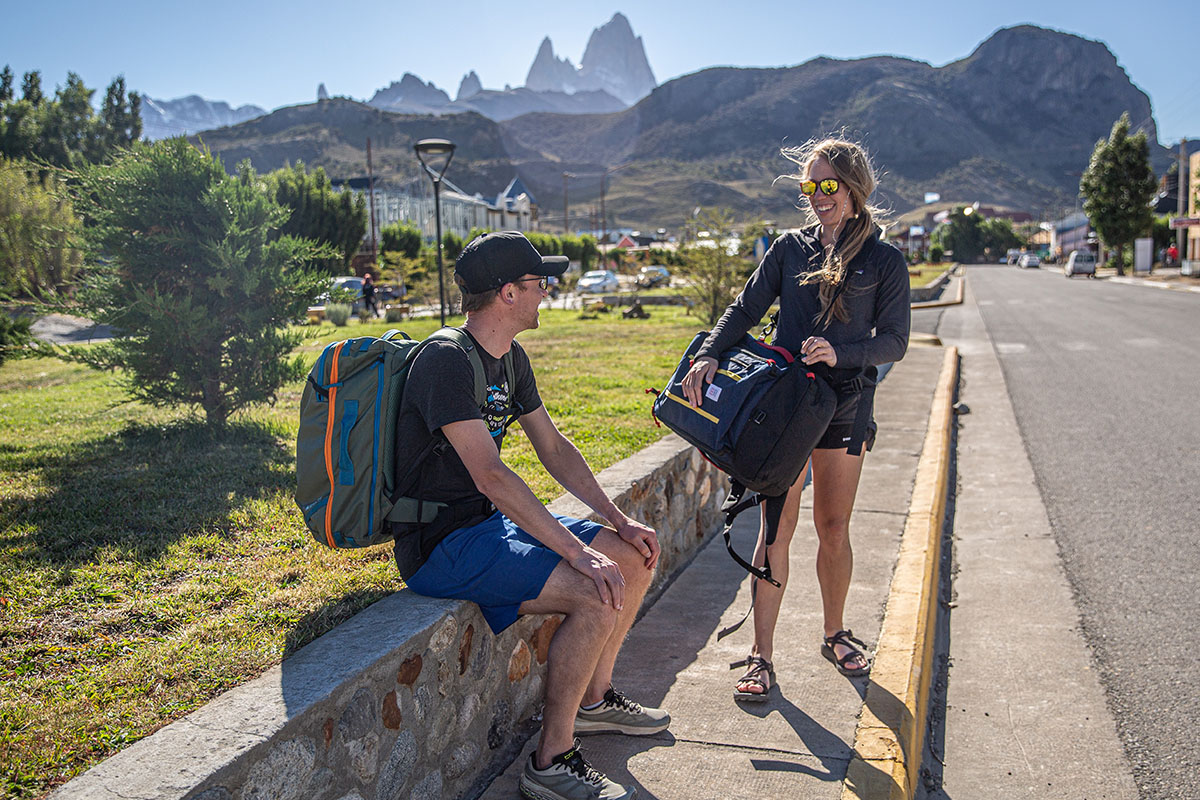
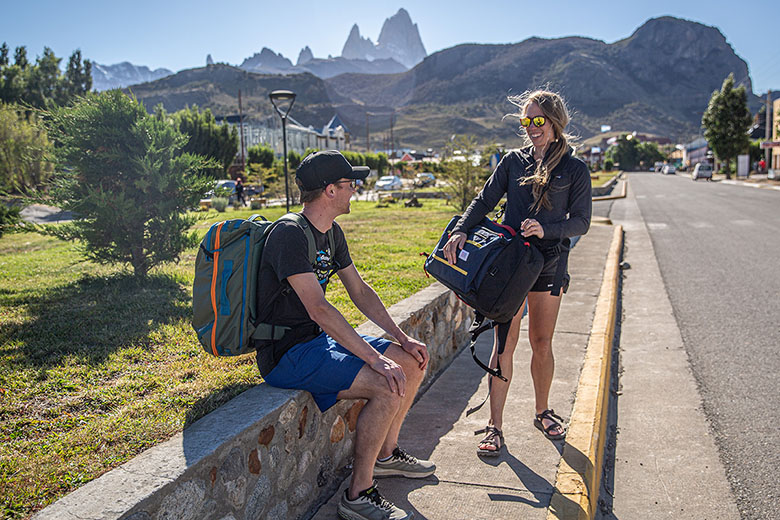
Whether you’re traveling across the globe or headed out on a quick weekend getaway, a thoughtfully designed travel pack can help you stay comfortable and organized while on the move. Key considerations include carry-on compatibility for air travel, enough capacity to stash your belongings, pack weight, and preferences on storage and organizational layouts. With these elements in mind, we hauled countless travel backpacks all over the world—from the bustling streets of Kathmandu to quaint towns around Europe—to hone in on our list of 18 worthy models below. These are our favorite travel backpacks of 2025, ranging from minimalist options for a couple of nights away to larger bags with removable daypacks for extended trips. For more background information, see our detailed comparison table and buying advice below the picks, along with details about our testing process.
Editor’s note: We updated our travel backpacks guide on April 30, 2025, to swap Cotopaxi’s Allpa 35L and Eagle Creek’s Tour 40L to their latest versions, add REI Co-op’s Ruckpack 40 to our list, and incorporate fresh photos from recent testing. We also swept the guide to ensure all information was up to date at the time of publishing.
 Capacity: 35L
Capacity: 35L
Dimensions: 22 x 12 x 10 in.
Weight: 2 lb. 15.0 oz.
Other sizes: 28, 42L
What we like: Very tough, well-executed organization, and fun styling.
What we don’t: No load lifters, water bottle storage, or exterior compression straps.
When compiling our list of the best travel packs, we prioritized functional organization, easy on-the-go access, durable materials, and carry-on compatibility. Cotopaxi’s Allpa 35L Travel Pack checks all those boxes emphatically, earning it our top spot for 2025. Along with the vibrant styling and multi-colored patterning that the brand is known for, the Allpa is exceptionally durable with a mix of 840-denier (D) TPU-coated and ballistic ripstop nylon, and, in use, we found it to be remarkably tough and highly water-resistant. We also love the full wraparound zipper for unrestricted access to the main compartment, and the electronics sleeve is big enough to handle both a laptop and tablet at the same time, which isn’t often the case. Finally, we appreciate that Cotopaxi addressed some of our complaints about the prior version during a recent update, adding a water bottle pocket, more breathable mesh shoulder straps, and a luggage pass-through sleeve for connecting the pack to a roller bag (although they did do away with the stowable rain cover).
What’s not to like with the Cotopaxi Allpa? While the 35-liter variation here is nicely sized for long weekend trips or shorter getaways abroad, it’s smaller than competitors like the Peak Design Travel Backpack, Osprey Sojourn Porter 46, and many other carry-on-friendly designs below (Cotopaxi does sell a larger 42L version for $250 that still meets most airline requirements). Further, while overall carrying comfort is good, there are no load-lifter straps to bring the pack closer to your body. Additionally, the interior pockets are a little awkwardly sized, and the lack of external compression straps makes it hard to secure bulkier loads. But in all reality, these are small complaints that do little to dampen our enthusiasm for an otherwise well-rounded and great-looking bag. And for those looking to check their luggage, the Allpa roller bags are equally tough and user-friendly.
See the Cotopaxi Allpa 35L

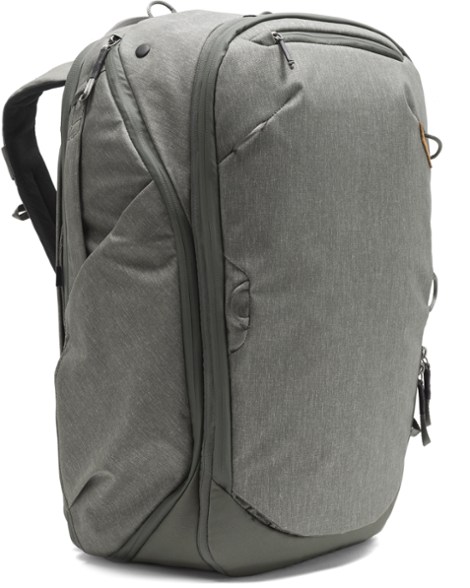 Capacity: 45L
Capacity: 45L
Dimensions: 22 x 13 x 9.5 in.
Weight: 4 lb. 8.0 oz.
Other size: 30L
What we like: Easy to access, expandable design, and thoughtful feature set.
What we don’t: Expensive, a little heavy, and too techy for some.
Peak Design’s Travel Backpack may look relatively unassuming on the outside, but don’t be fooled: This bag is packed with thoughtful travel-ready features. First is the expandable design, which allows you to alternate between 35 and 45 liters by simply zipping or unzipping the frontmost zipper. Access is another highlight, including entry points at the top, side, front, and rear for easily retrieving items pretty much anywhere in the pack. Storage is also excellent with padded laptop and tablet sleeves, a divisible main compartment, large and stretchy dual side pockets (not common on travel packs), and multiple interior pockets. And it’s all wrapped up in a thick nylon canvas shell that’s durable, streamlined, and very modern.
What complaints do we have about the Peak Design Travel Backpack? Price is the most glaring downside: At $300, it’s one of the most expensive designs on our list. And while the bag is undeniably sleek, it’s pretty utilitarian-looking and less everyday-friendly than more vibrant options like the Cotopaxi Allpa above and Topo Designs Global Travel Bag below. It’s also on the heavy end at 4 pounds 8 ounces, which isn’t unreasonable but does add considerable heft compared to many competitors. Finally, the Travel Backpack is technically not carry-on compliant when expanded, measuring 22 x 13 x 11 inches (the standard U.S. domestic carry-on limit is 22 x 14 x 9 in.). But it works at the compressed 35-liter size (or smaller 30L option), and photographers in particular will love the shape, which nicely accommodates multiple camera cubes, lenses, and other accessories. For daily use, we're also big fans of Peak Designs' Everyday 20L Backpack Zip, which bears a strong resemblance to the travel pack in a lighter, smaller, and cheaper package.
See the Peak Design Travel Backpack
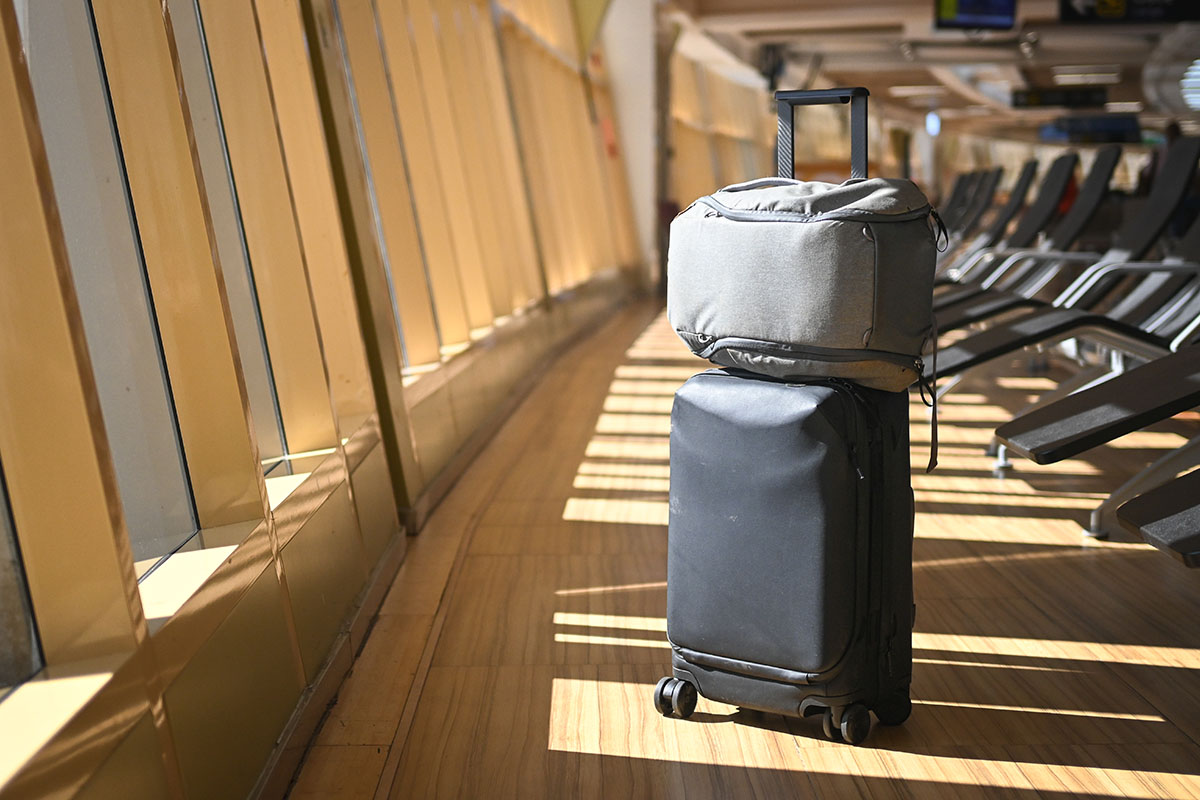
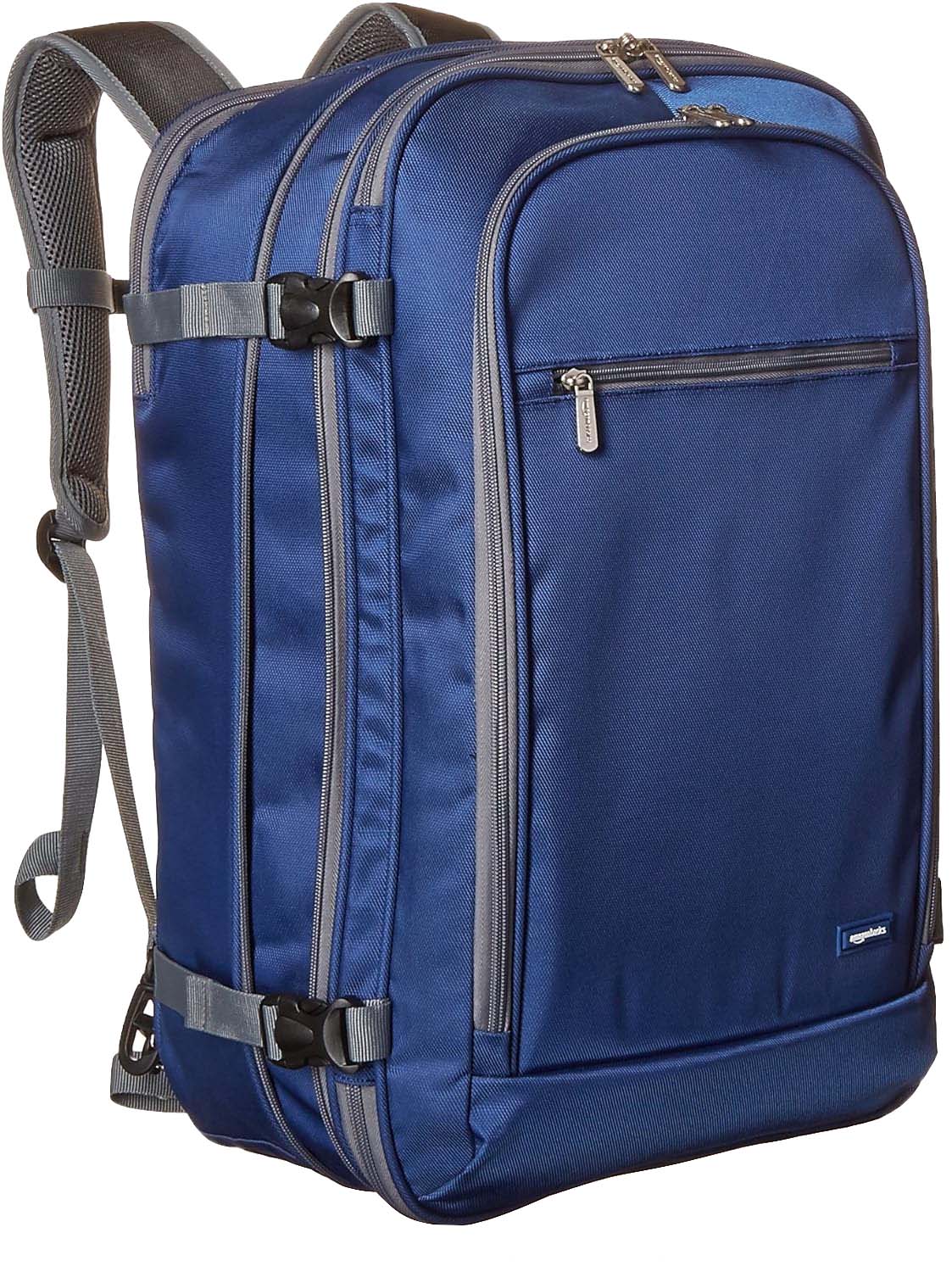 Capacity: 40L
Capacity: 40L
Dimensions: 21.5 x 15.75 x 8.25 in.
Weight: 3 lb. 10.2 oz.
Other sizes: None
What we like: Good capacity and organization for far less than the competition.
What we don’t: Lacking in padding and support for shuttling heavy loads; no lockable zippers.
Travel packs are an expensive bunch, but Amazon makes an affordable but still surprisingly capable option in their Carry-On Travel Backpack. We’ll start with the good news: As its name implies, the bag is carry-on compliant, and it comes with most of the standard features we look for in a practical travel pack. These include a zippered laptop sleeve, internal and external compression straps, easy-access pockets for travel documents, and good organization in the main compartment. Like the Peak Design Travel Backpack above, the Amazon Basics can also be expanded to boost packing space while still meeting carry-on restrictions. And at just around $50 at the time of publishing (colorways vary on Amazon), the 40-liter Carry-On Travel Backpack is a great value for what you get, undercutting most similarly sized models on this list by $100 or more.
Now for the bad news: This Amazon Basics pack is far less capable than many of the picks here for shuttling a full load. The shoulder straps are lightly padded, while the hipbelt is a thin and basic webbing design that won’t feel comfortable under the weight of a full pack. The rest of the design has a cheaper feel, too, including a shiny and dated-looking exterior, a lot of plastic (read: breakable) components, and standard, non-lockable zippers. You don’t get dedicated water bottle storage either, which isn’t a necessary feature but certainly is nice to have. But if you’re an occasional traveler and aren’t yet ready to make a more sizable investment, the Amazon Basics pack is a perfectly serviceable entry-level option at a great price. For another capable budget design that comes with packing cubes and lots of colorway options, we also like Asenlin’s 40L Travel Backpack.
See the Amazon Basics Carry-On Travel Backpack
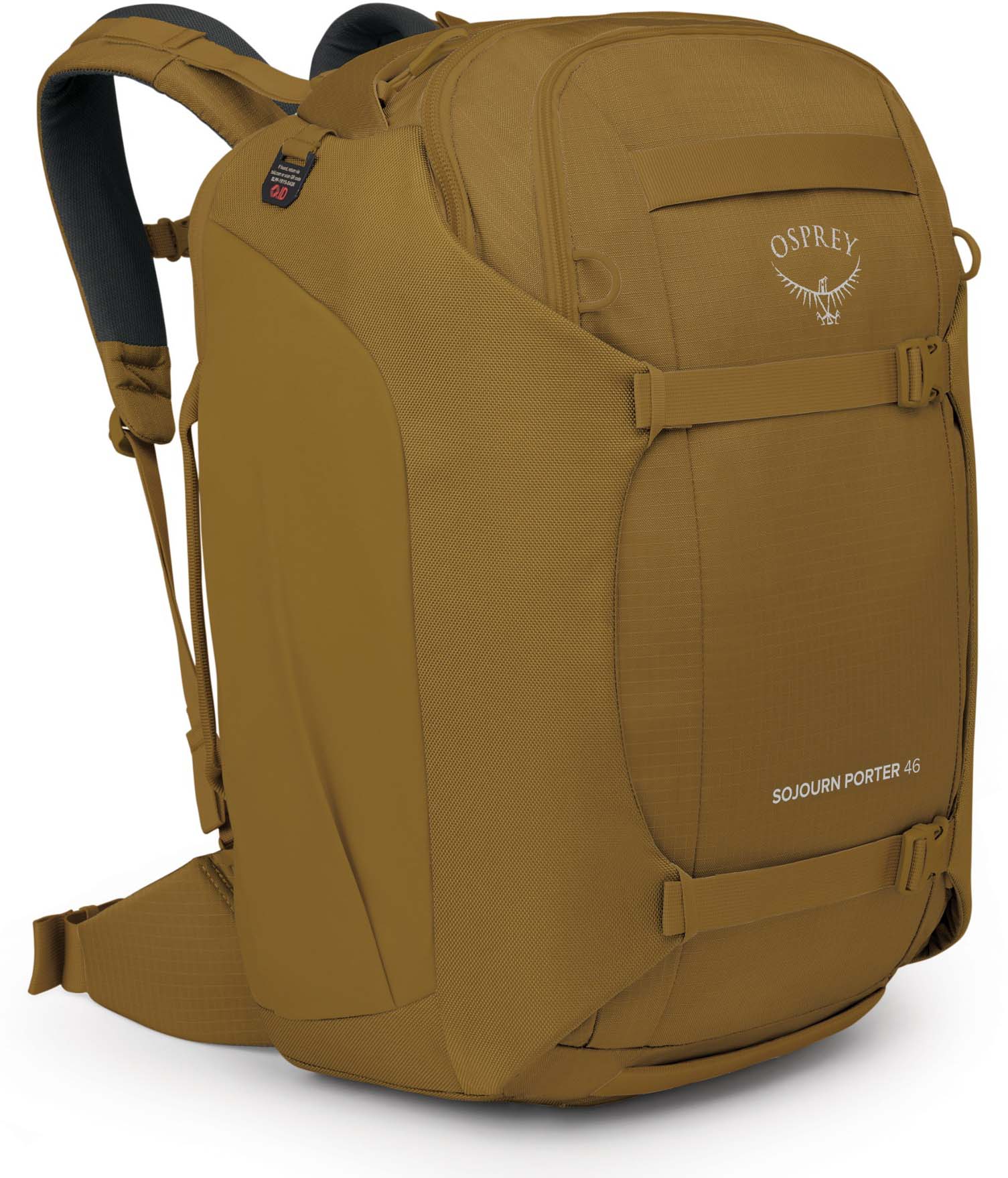 Capacity: 46L
Capacity: 46L
Dimensions: 18 x 15.75 x 12.2 in.
Weight: 3 lb. 7.2 oz.
Other sizes: 30, 65L
What we like: Practical, generous storage, and purpose-built for adventure travel.
What we don’t: We wish there were a women's-specific variation.
Osprey is a leader in the backpacking pack market, and much of that technology and expertise has trickled down nicely into their travel pack collection. The Sojourn Porter 46 L is a case in point, combining the impressive carrying comfort that the brand is known for with a practical, carry-on-friendly build and feature set for travel. Starting at the outside, you get a rigid foam back panel with well-cushioned shoulder and hipbelt straps that feel reminiscent of Osprey’s backpacking designs, a handy compression system to effectively cinch things down, lockable zippers for the main compartment, and a beefy side handle for hauling the pack duffel-style. The inside is a similar story with ample pockets of varying sizes, compression straps to keep clothes tidy, and padded sidewalls to help protect valuables during travel.
Despite offering 11 more liters of capacity than our top-ranked Cotopaxi Allpa 35L (for $30 less), the Sojourn Porter 46 L is still carry-on compliant, making it the largest option here that still meets most domestic and international airline restrictions. It’s also impressively sturdy and durable and includes reinforced cord loops to attach to Osprey's Daylite or Farpoint/Fairview daypacks (sold separately). We do wish Osprey offered the design in a women’s version for those with smaller torso and waist measurements, but the unisex sizing is standard in the travel market (their Farpoint/Fairview below is one of the few models to come in a separate women’s version). In the end, if it fits you well, the Sojourn Porter offers a hard-to-beat mix of capacity, features, and comfort for the price, making it our favorite option for longer, gear-intensive adventures.
See the Osprey Sojourn Porter 46 L
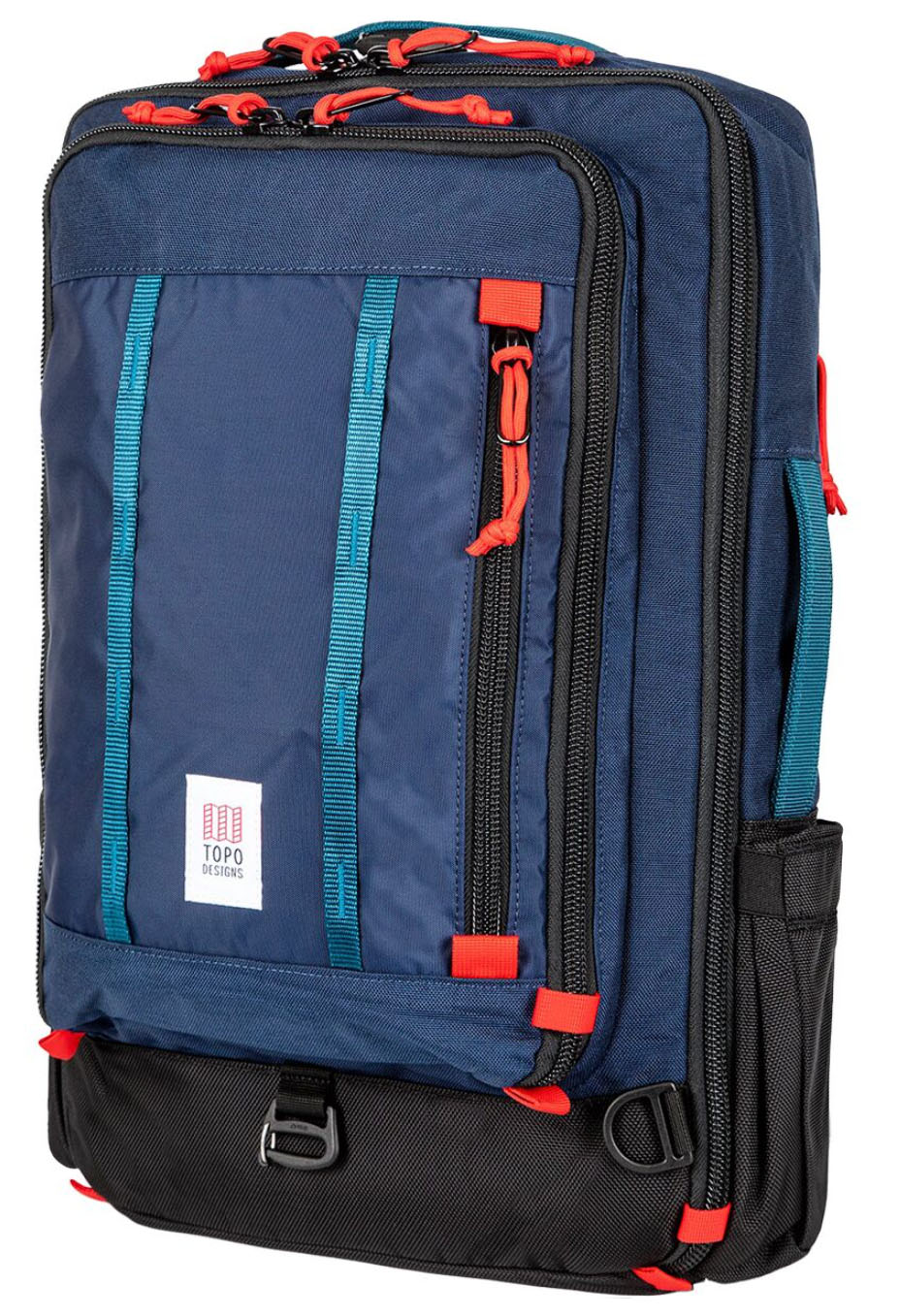 Capacity: 30L
Capacity: 30L
Dimensions: 20 x 12.5 x 7 in.
Weight: 2 lb. 10.0 oz.
Other size: 40L
What we like: Seemingly limitless organization, stylish, and very thick materials.
What we don’t: Complex build and straps could be a little more cushioned.
Topo Designs flies a little under the radar compared to well-known brands like Cotopaxi and Osprey, but don’t let that deter you—this company makes exceptionally built and good-looking packs for everything from commuting and travel to more technical pursuits like biking and climbing. Their Global Travel Bag 30L here is a shining example and stands out in one major way: internal organization. Put simply, there’s no shortage of options for divvying up your belongings, from the vertical daisy chain webbing on the front to the expandable side water bottle pockets, ample zippered storage inside and out, a laptop sleeve along the backpanel, and several interior mesh pockets. Like the Cotopaxi Allpa above, the Global Travel Bag is also well equipped for rough use, including a mix of 1,000D and 1,680D ballistic nylon that gives the pack a noticeably burly, confidence-inspiring feel—at a very manageable 2 pounds 10 ounces to boot.
That said, the extensive feature set does add some complexity when it comes to organization. We like the big clamshell opening to the main compartment, but we had to reorganize to make everything fit into the various compartments (they're optimized for Topo Designs' Pack Bags, which are smaller than our standard packing cubes). The tall and slim shape is also best suited for clothing rather than bulky gear, which may be limiting for outdoor adventures that involve camping or backpacking. We also wished there was a bit more padding along the shoulder straps and hipbelt while walking through airports with the pack stuffed full, but it distributed the load pretty well (and the hipbelt can be tucked away when not in use). In the end, no pack is perfect, but the Global Travel Bag 30L is a well-built, durable, and stylish option for overnights, short weekend getaways, and even minimalist adventures abroad. It’s also sold in a larger 40-liter variation for longer trips, although we found the smaller pack to be much more manageable.
See the Topo Designs Travel Bag 30L
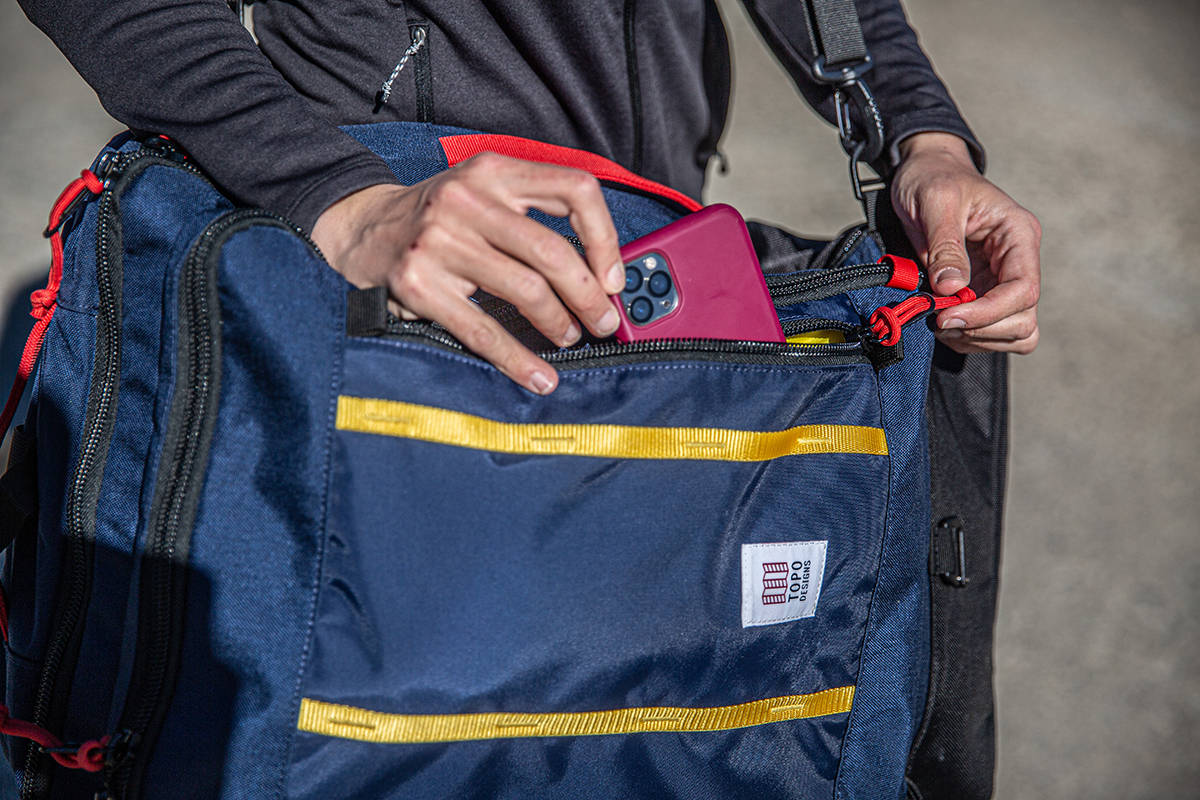
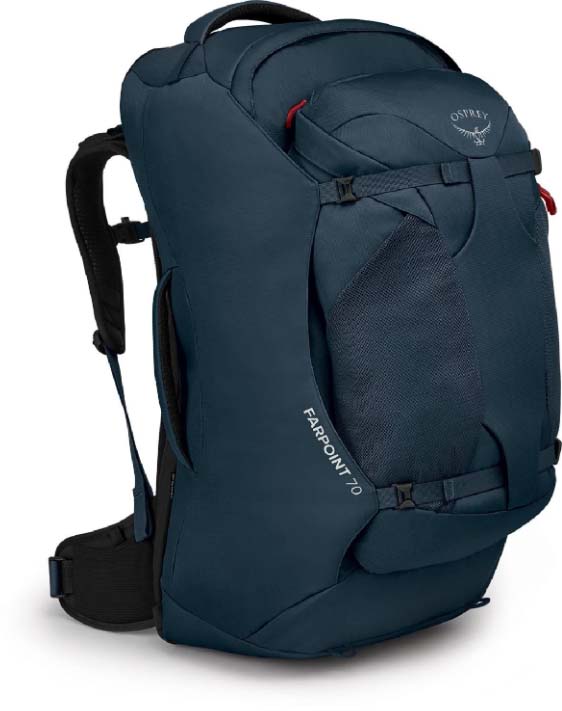 Capacity: 70L
Capacity: 70L
Dimensions: 25.6 x 15 x 12.6 in.
Weight: 5 lb. 6.6 oz. (men's ), 4 lb. 8.0 oz. (women's)
Other sizes: 40, 55, 80L
What we like: Massive capacity with a removable and functional 15-liter daypack.
What we don’t: Doesn’t meet carry-on size requirements; the heaviest option on our list.
The packs above are great for vacationers and travelers headed out for a week or two, but those embarking on longer and/or gear-heavy trips abroad will almost certainly need more storage and capacity. Enter Osprey’s Farpoint 70 (and women's Fairview 70), which comes with a 15-liter daypack that can be attached to the front to maximize capacity or used separately for around-town adventures once you reach your destination (Note: The travel pack itself is 55L). Importantly, both come well appointed: The daypack boasts a dedicated tablet/hydration sleeve and water bottle pockets, while the main pack has great cushioning along the straps and backpanel (it’s an Osprey, after all), a well-ventilated backpanel, easy access via the large front panel, and an adjustable torso system for dialing in a good fit. It's all wrapped up in a thoughtful and sustainable package, including recycled and bluesign-approved fabrics, along with a dedicated women's version called the Fairview.
All that said, there’s one glaring downside to opting for a larger-capacity design like the Farpoint and Fairview 70: It doesn’t meet most carry-on size requirements. For reference, the standard domestic carry-on limit within the U.S. is 22 x 14 x 9 inches, while the Farpoint measures 25.6 x 15 x 12.6. Another complaint is that the daypack obscures the pack’s main compartment when attached, making it tedious to access your belongings. Even so, you’d be hard-pressed to find a more versatile and comfortable system for less (the daypack is a $65 investment on its own), making the Farpoint and Fairview our favorite high-capacity pick of the year. It’s also available in a larger 80-liter version, as well as smaller 40- and 55-liter capacities, although only the Farpoint 55 (and Fairview 55) and 70 include the detachable daypack.
See the Men's Osprey Farpoint 70 See the Women's Osprey Fairview 70
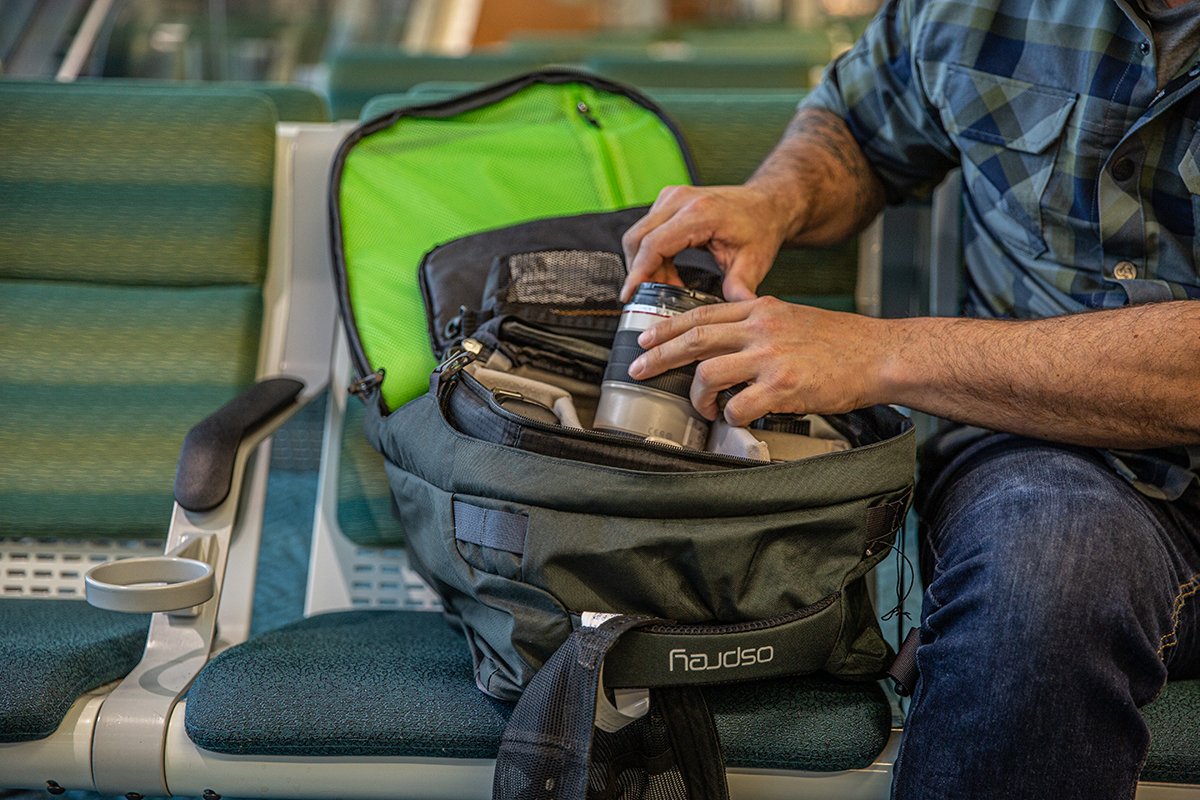
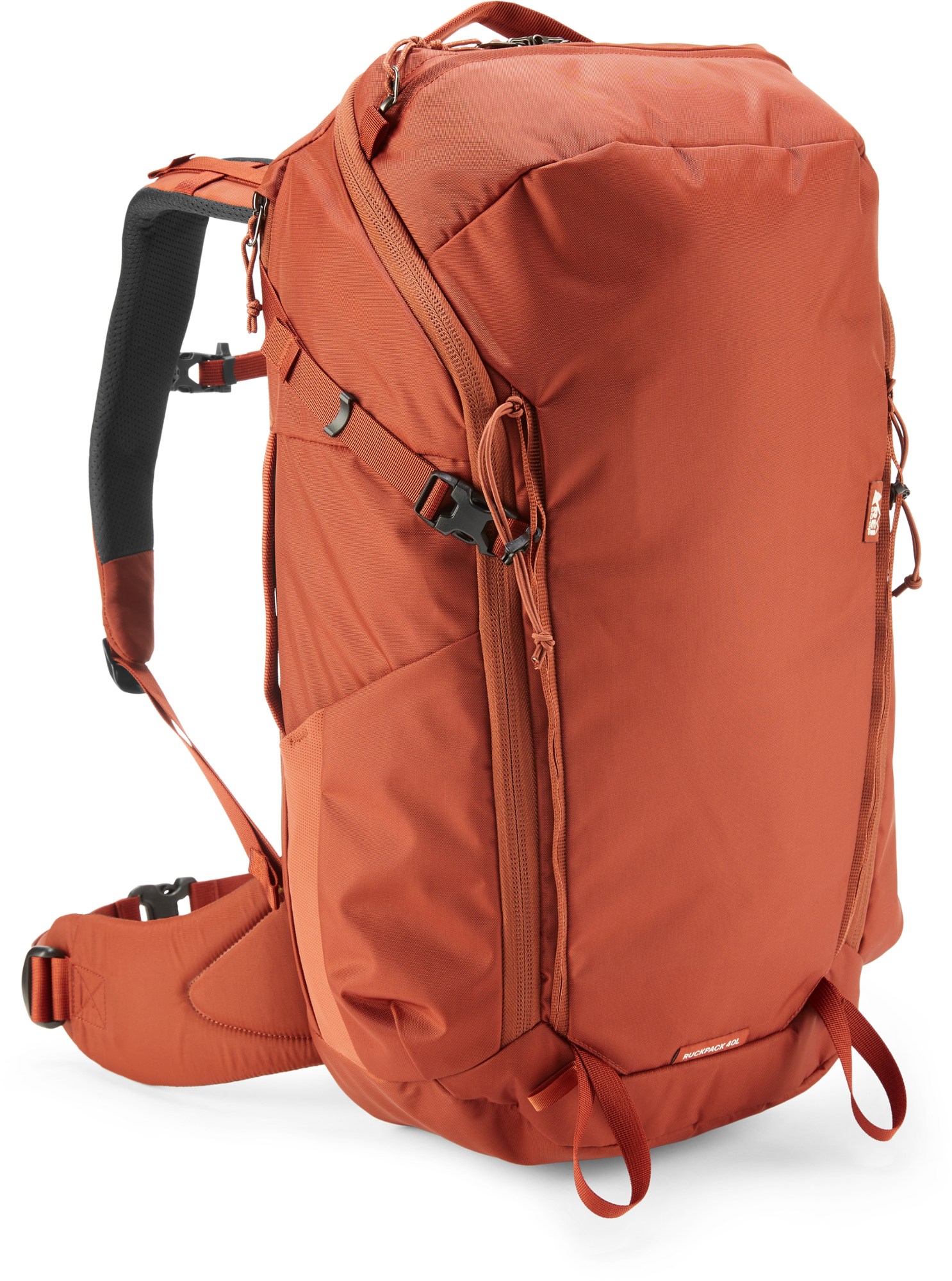 Capacity: 40L
Capacity: 40L
Dimensions: 23 x 15 x 9.5 inches
Weight: 2 lb. 13.0 oz. (men's), 2 lbs. 11.0 oz. (women's)
Other size: 18, 30L
What we like: Competitive balance of price, organization, weight, and carrying comfort; crosses over nicely for hiking.
What we don’t: Makes some sacrifices in the name of versatility, including an unpadded laptop sleeve and no internal divider.
REI Co-op is known for providing reliable gear at palatable price points, and the Ruckpack 40 is no exception. For a very competitive $159, the Ruckpack checks a whole lot of boxes for occasional and well-versed travelers alike: It’s comfortable to carry thanks to a backpacking pack-like suspension system that nicely distributes weight, easy to access and organize with a generous U-shaped opening and practical zippered storage, and impressively light for the capacity at 2 pounds 13 ounces. The Ruckpack also crosses over decently well for hiking—especially in the smaller capacities—with a sleeve and port for a hydration bladder, trekking pole attachments, dual water bottle pockets, and even an included rain cover (the 18L version has one water bottle pocket and no cover). Finally, the pack is available in both men’s and women’s styles with two size options for each, offering the most customizable fit of any design to make our list this season.
However, as with most designs that aim to do it all, the REI Ruckpack does make some concessions in the name of versatility. First, while the hydration reservoir sleeve can fit a 15-inch laptop, it’s not padded, which isn’t ideal for protecting electronics during travel. Additionally, the U-shaped zipper doesn’t open up as wide as the clamshell-style openings found on many alternatives here, making it tougher to reach contents at the very bottom of the bag. Finally, there’s no internal divider or compression straps inside the main compartment, although our tester found packing cubes to be just as effective—if not more so—for organizing her clothing and toiletries. Taken together, the Ruckpack is a highly versatile and thoughtfully built design at a great price, landing it a very respectable finish on our list this season.
Read more: women’s REI Co-op Ruckpack 40 review
See the Men's REI Ruckpack 40 See the Women's REI Ruckpack 40
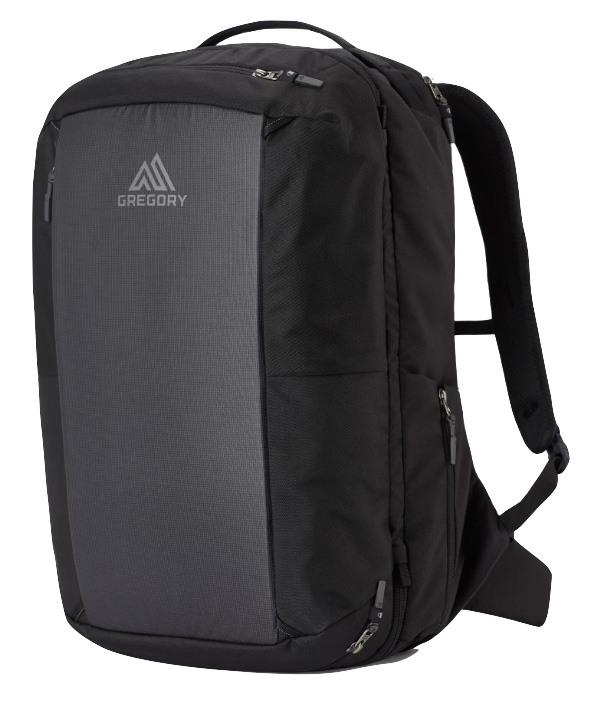 Capacity: 40L
Capacity: 40L
Dimensions: 22 x 14 x 9 in.
Weight: 2 lb. 14.9 oz.
Other size: 30L
What we like: Very comfortable to carry and separate compartment for dirty clothes.
What we don’t: Split-case design limits storage space; less durable than the Osprey packs above.
Like Osprey, Gregory is a leader in the hiking and backpacking markets, and their Border Carry-On 40 retains many of their well-loved technical features in a travel-friendly design. The big news here is the pack’s split-case design, which creates two distinct areas within the main compartment accessed via one large, clamshell-style opening. On one side, a zippered mesh panel with added zippered storage and compression straps keeps your clothing and some accessories organized, while an odor-resistant “ActiveShield” compartment at the opposite side effectively separates dirty clothes. As expected from Gregory, carrying comfort is also great with good adjustability at the sternum, a well-cushioned backpanel, and thick straps. You don’t get load lifters for bringing the pack closer to your body, but we didn’t have any issues, even when running through the Montreal airport to a connecting flight en route to Patagonia.
That said, the Gregory Border Carry-On’s split-case design does have a noteworthy pitfall: With both compartments zipped, storage feels pretty limited. Unzipping the larger mesh panel does help maximize space (especially when stuffing the pack to the brim), but it also defeats the purpose of the dual compartments. Compared to the competition, the Border also uses thinner materials than Osprey’s Sojourn Porter and Farpoint offerings, although the rest of the feature set stacks up similarly. In the end, it’s another comfortable and well-built travel pack, and the split-case design has its merits for those who pack light.
See the Gregory Border Carry-On 40
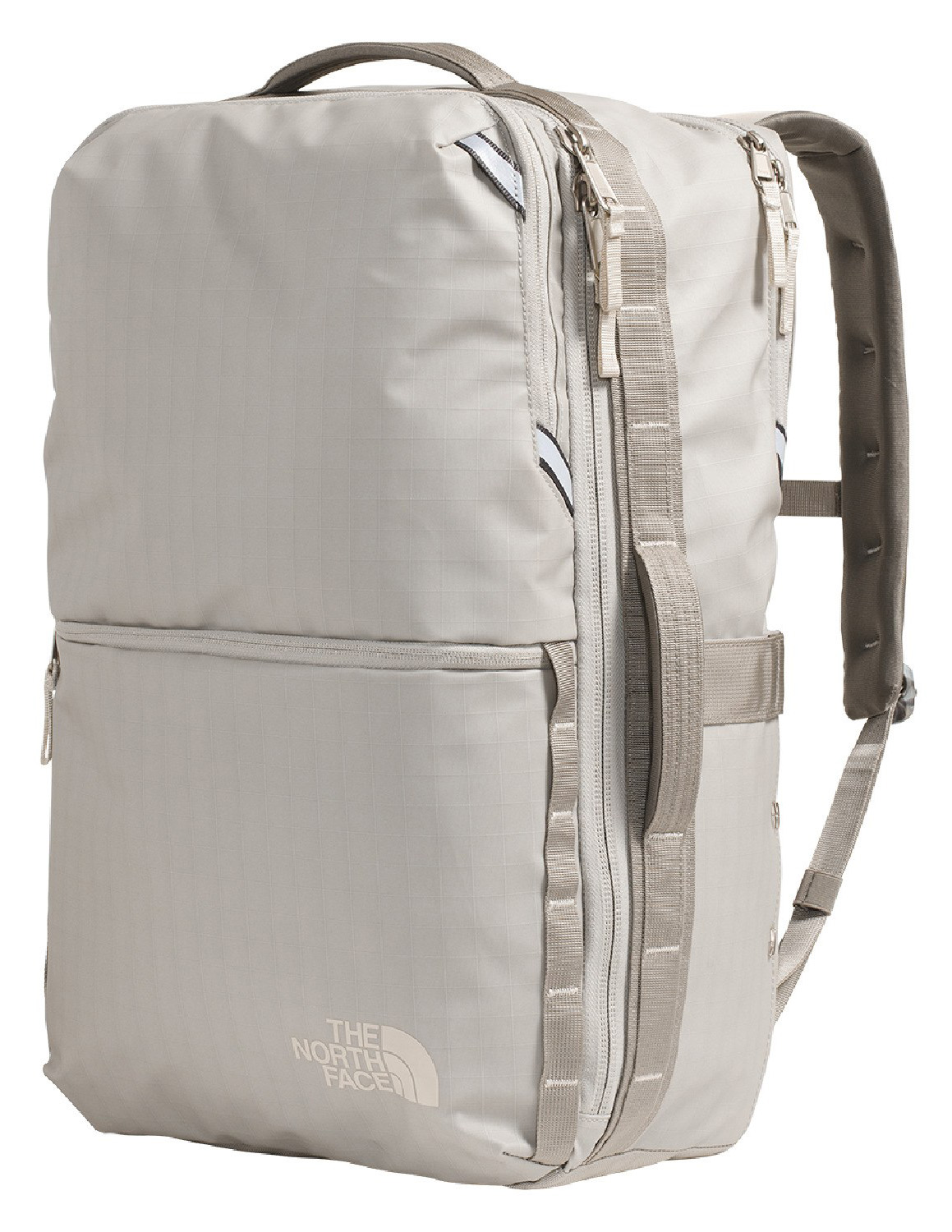 Capacity: 35L
Capacity: 35L
Dimensions: 19.3 x 12 x 6.3 in.
Weight: 3 lb. 7.0 oz.
Other sizes: None
What we like: Checks all the boxes for most travelers without breaking the bank.
What we don’t: Some reports of discomfort from the shoulder straps; you can go bigger for the price.
The North Face’s expedition-ready Base Camp duffels have long been popular among serious adventurers, and the Base Camp Voyager travel pack is a logical and carry-on-friendly addition to the collection. We found a lot to like about the pack during testing, including its burly and abrasion-resistant exterior and myriad storage options. We particularly enjoyed the Base Camp’s front pocket layout, which makes it easy to divvy up travel documents and electronics with a variety of mesh, zippered, and oh-so-soft fleece-lined pockets. The smaller details are equally well sorted, from the well-padded shoulder straps and backpanel to the fleece-lined laptop sleeve and generous daisy chain system for attaching gear externally. Finally, despite being a little smaller than many of our top picks, the 35-liter Base Camp Voyager includes water bottle pockets that easily swallowed our 24-ounce Hydro Flask. It all adds up to a very strong value for what you get.
However, despite checking all the boxes for most travelers, the Base Camp starts to look a little less competitive when stacked up against options like the REI Ruckpack 40 above. For around $10 less, the REI is more capable of crossing over for hiking with a hydration bladder-friendly sleeve inside the main compartment, attachment points for trekking poles, and a suspension system that’s more in line with standard daypacks. Depending on your needs, the Ruckpack might be the better option, but the Base Camp Voyager offers better organization for travel in a more modern-looking package. A final note: Those with broader builds may experience discomfort where the shoulder straps meet the backpanel, but our narrow-framed female tester had no comfort-related issues.
See the TNF Base Camp Voyager
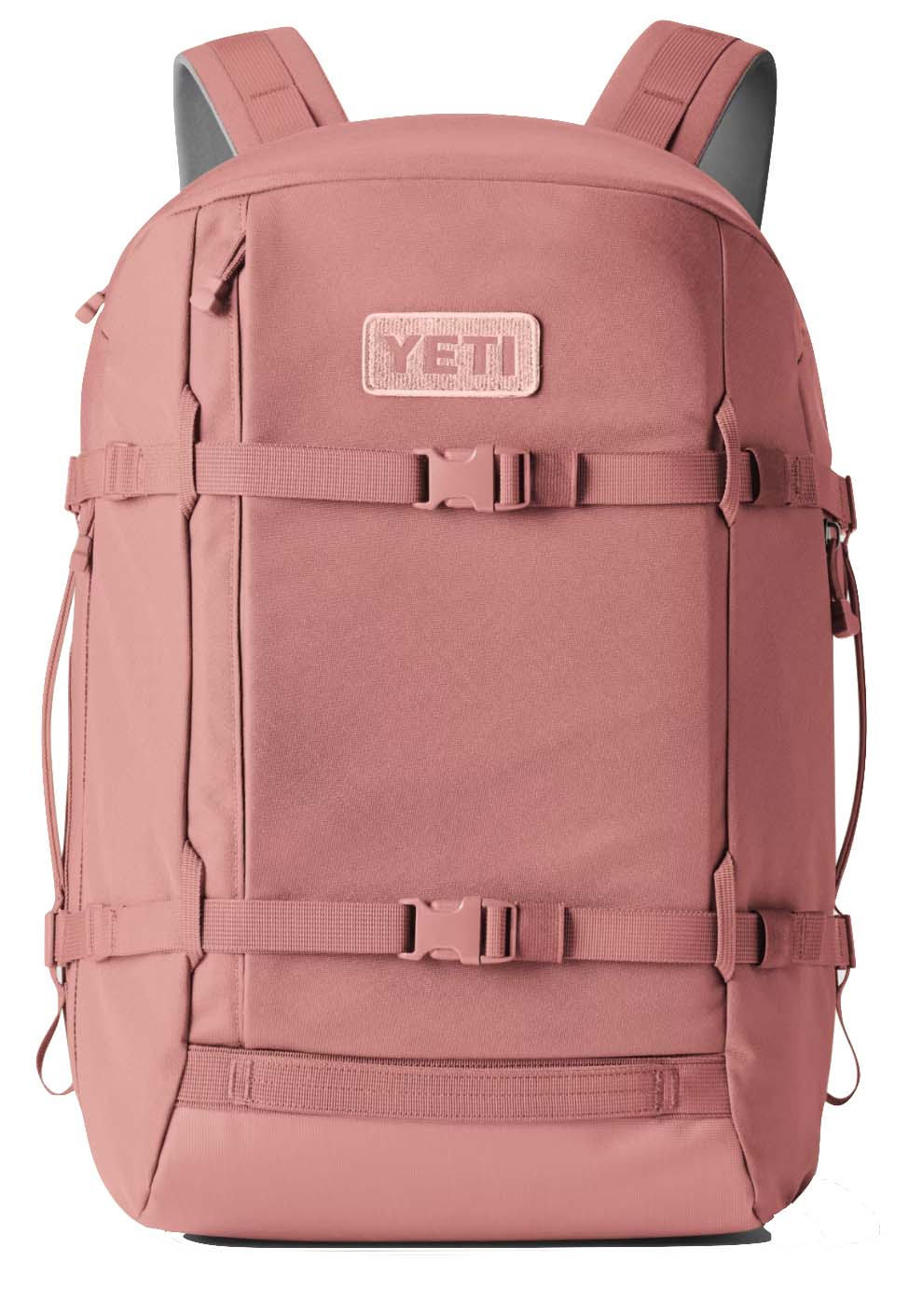 Capacity: 35L
Capacity: 35L
Dimensions: 20 x 13 x 8 in.
Weight: 3 lb. 11.2 oz.
Other sizes: 22, 27L
What we like: High-end Yeti construction and top-notch durability.
What we don’t: Expensive and heavy for the capacity; webbing hipbelt detracts from overall comfort.
Yeti's coolers and insulated drinkware are their bread and butter, but the focus on premium craftsmanship doesn’t end there. On the travel side, their Crossroads 35L Backpack is exactly what we’ve come to expect from the brand: excellent durability and functionality in a modern package. The body of the pack is made with Yeti's tough and confidence-inspiring TuffSkin nylon (which was inspired by motorcycle gear), while the PU-coated base adds a nice dose of assurance when setting it down. All of the other components have an equally durable and supportive feel, from the foam-heavy shoulder straps to the thick, protective backpanel. It’s all wrapped up in a sleek and streamlined design that’s offered in a nice selection of colorways, from bright Sandstone Pink (shown in the photo here) to subdued Alpine Brown.
Yeti clearly put a lot of thought into the outside of the Crossroads, but the interior is well executed, too. The clamshell opening folds back to reveal a pocket-equipped mesh panel and generous main compartment that still can be accessed when wearing the pack. You also get dedicated storage for a water bottle and laptop, as well as a pass-through sleeve for securing to a roller bag. Our biggest gripe is the lack of padding: The detachable hipbelt is made of thin webbing and doesn’t offer much support, and the shoulder straps and backpanel have a noticeably thick and rigid feel, which is great for durability but detracts from overall comfort. And as with most Yeti products, the pack isn’t particularly cheap or light at $250 and nearly 4 pounds. Finally, the 35-liter Crossroads is on the smaller side and will require precise packing to fit more than about three to five days’ worth of belongings. But again, build quality is top-notch, and minimalists used to packing light may not mind the small sacrifices in comfort and storage.
See the Yeti Crossroads 35L Backpack
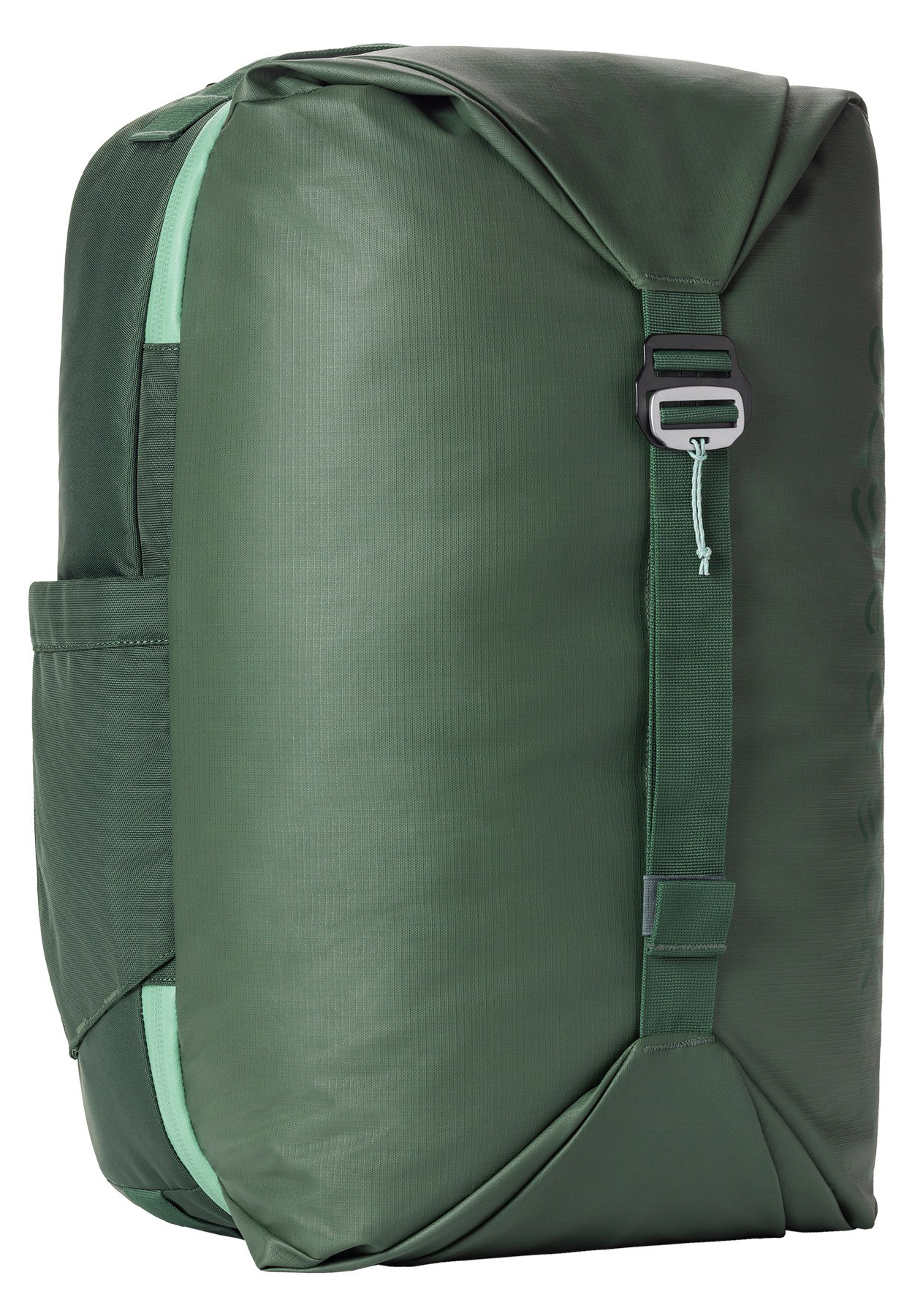 Dimensions: 20.5 x 13 x 8.75 in.
Dimensions: 20.5 x 13 x 8.75 in.
Weight: 3 lb. 4.0 oz.
Other size: 55L
What we like: Functional organization inside and out; expands to accommodate bulkier loads.
What we don’t: Considerably pricier and heavier than the prior version; no longer offered in two sizes.
Eagle Creek first started making packs in the mid 1970s, and their Tour 40L travel pack reflects that longstanding history in the market. For starters, the bag has great exterior storage, including a stretchy side water bottle pocket and an expansion zipper for boosting capacity in the main compartment (when expanded, the pack measures 20.5 by 13 by 10.75 inches). Additionally, the book-style opening provides quick access to the contents of the pack, and interior and exterior compression straps make it easy to snug things down. Other notable features on the Tour include side and top grab handles for easy loading and carrying, puncture-resistant and lockable zippers that are easy to operate even with gloves, and good overall carrying comfort.
However, we feel Eagle Creek’s most recent update to the Tour was a step back in many ways. While the prior version was a standout value at $149, the latest model costs a less competitive $249 and weighs a considerable 10 ounces more. It’s also no longer offered in two sizes, which lines up with the rest of the market but was nevertheless a selling point of the past-generation Tour. On the bright side, the Tour can now be attached to rolling luggage via the grab handle, which doubles as a trolley sleeve, and the design is a little more modern-looking overall. In the end, while we feel the latest Tour is less of a standout than its predecessor, it’s still a well-built travel pack from a respected brand, earning it a spot on our list this season.
See the Eagle Creek Tour 40L
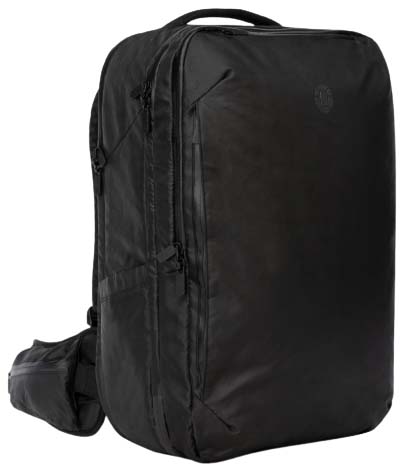 Capacity: 40L
Capacity: 40L
Dimensions: 21.7 x 13.8 x 7.9 in.
Weight: 4 lb. 8.0 oz.
Other sizes: None
What we like: All the features we look for in a quality, well-rounded travel pack.
What we don’t: Heavy and the most expensive design here.
Travel packs are a dime a dozen in 2025, but Tortuga’s Travel Backpack Pro 40L—which replaced their Outbreaker 35L—stands out as one of the most well-appointed and thoughtfully built options on the market. Organization is a clear highlight, including a large front pocket with several sleeves for divvying up small valuables and documents, a convenient clamshell-style opening with zippered compartments for separating clothes and shoes, and padded laptop and tablet sleeves with zippered mesh pockets at the other side for storing cords and accessories. Rounding out the feature set are easy-to-access water bottle pockets that can fit most standard-mouth bottles (our wide-mouth Hydro Flask was too big), zippered hipbelt storage that can accommodate a smartphone and passport, and lockable, water-resistant zippers. Finally, the design is well padded with thick cushioning along the backpanel, shoulder straps, and hipbelt, which is fairly uncommon among travel-specific brands.
It's worth noting that the Tortuga Travel Backpack Pro has a slightly more streamlined storage layout than its predecessor, although you do get an additional 5 liters of capacity and a bump in usable space. However, the Tortuga is no featherweight at 4 pounds 8 ounces, which is a notable downside for long treks through the airport and around town. It’s also the priciest option on our list at $375, which the average traveler will likely find hard to justify. On the bright side, Tortuga does offer a lifetime warranty against defects, and they will repair/replace the pack or refund your money if a replacement isn't available. All told, it’s a nice dose of added assurance and helps justify the steep price, but the hefty build and lack of value push the Tortuga slightly down in our rankings. For another well-executed design with all the requisite travel features, check out Aer’s Travel Pack 3, which is cheaper at $249 but 5 liters smaller and doesn’t include a hipbelt with purchase.
See the Tortuga Travel Backpack Pro 40L
 Capacity: 45L
Capacity: 45L
Dimensions: 22 x 12.8 x 11 in.
Weight: 4 lb. 8.0 oz.
Other size: 35L
What we like: Backpacking pack-like comfort and support with excellent organization for travel.
What we don’t: Arguably overbuilt and overpriced for the average traveler.
Matador may lack the name recognition of brands like Osprey and Cotopaxi, but don’t let that fool you: This Boulder-based upstart is quickly growing thanks to their outside-the-box thinking. From their travel collection, the GlobeRider45 stands out as a very intentionally built design that spares no expense in terms of features. In addition to being on the larger end, the carry-on-compliant GlobeRider offers solid comfort and support with good padding along the straps and backpanel, a light but sturdy aluminum frame stay, and a well-executed suspension system that’s reminiscent of a backpacking pack. Organization also abounds with a large external stash pocket, thoughtfully designed electronics pockets, vertical daisy chain webbing, and a practical interior layout that includes a packing cube-like space on one side and open clothing storage on the other. All told, it's an intriguing pack that does a great job merging the utility of both backpacking and travel designs.
It's worth noting that we previously had Matador’s cheaper and lighter Seg45 ranked here, which boasts a unique segmented design that allows you to customize organization by day or activity. When unzipped, the five compartments at the front of the pack reveal independent (and stowable) storage cube-like areas for clothes and other soft items, while the main compartment below provides added space for dirty clothes, shoes, and other bulkier gear. While innovative, however, the Seg45 falls well short of the GlobeRider in carrying comfort, which is largely a result of the thin webbing hipbelt and lack of frame. The pocket-heavy exterior also made it hard for us to remember where we put certain items and detracts from the amount of usable space inside the main compartment. Both packs are arguably overbuilt for infrequent travelers, but the GlobeRider stands out as the more balanced option for those willing to splurge.
See the Matador GlobeRider45
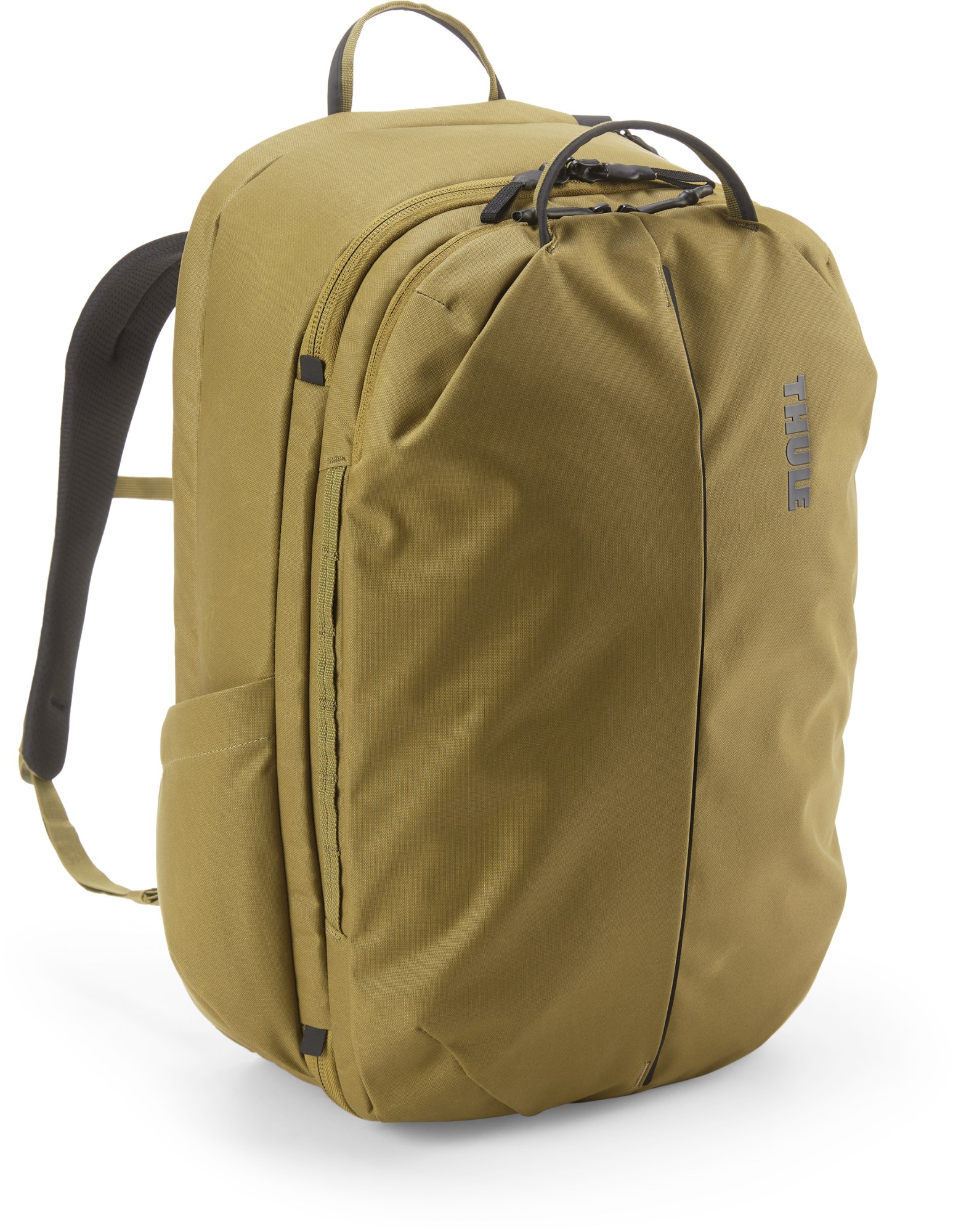 Capacity: 40L
Capacity: 40L
Dimensions: 20.5 x 13 x 9.1 in.
Weight: 3 lb. 3.0 oz.
Other size: 28L
What we like: Premium build quality; removable rolltop bag is handy for dirty clothes.
What we don’t: Hipbelt sold separately.
Swedish brand Thule is best known for their bike and roof racks, but they make sneaky-good packs, too. Our favorite in their collection this year is the 40-liter Aion, which combines the premium build quality that Thule is known for with a nice assortment of travel-ready features. One unique—but very functional—addition is the removable TPU rolltop bag for stashing dirty laundry, which prevents odors and dirt from making their way to the rest of your belongings. The rest of the design is nicely appointed, including dedicated water bottle storage, an easy-to-access clamshell opening, plenty of zippered spaces for electronics and valuables (including a padded laptop/tablet sleeve), internal compressions straps to keep items secure and tidy, lockable zippers, and carry-on-compliant dimensions.
What pushes the Thule Aion down in our rankings? At this price point and capacity, we’re surprised to see that the bag doesn’t come with a hipbelt. You can purchase Thule’s compatible Aion sling bag separately, which can pull double-duty for around-town use, but it’s a fairly expensive addition at $50 (and a feature we consider critical for a pack of this size). To be fair, the rest of the build is very well executed, including a noticeably thick and robust 600D waxed canvas shell and PFAS-free DWR coating for fending off moisture. If you don’t mind the added investment for the waist belt/sling bag, it’s a promising design with competitive specs to match. For $40 more, it's also worth considering Thule's Landmark 60L, which comes with a padded hipbelt and features a removable daypack. The Aion carries more comfortably (attaching the Landmark's daypack can make for an unwieldy experience) and offers better durability, but the Landmark has its advantages.
See the Thule Aion Travel Pack
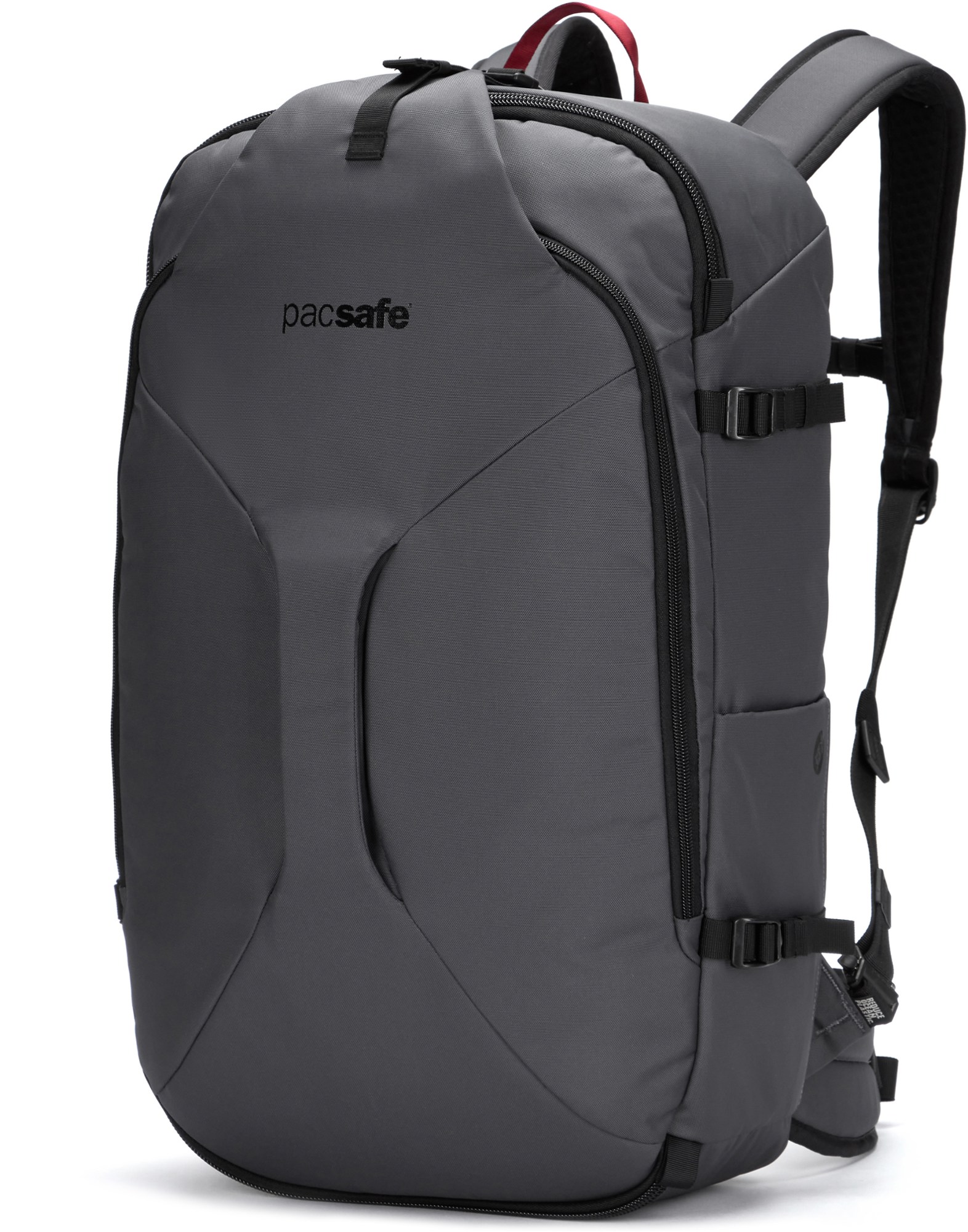 Capacity: 45L
Capacity: 45L
Dimensions: 21.7 x 13 x 7.5 in.
Weight: 3 lb. 15.5 oz.
Other sizes: 35L
What we like: Anti-theft technology and cut-resistant fabrics add a nice dose of assurance.
What we don’t: Pricey and prioritizes safety features over carrying comfort.
Travel can be an exhausting endeavor, especially if you’re constantly worried about your luggage or valuables getting stolen. That’s why anti-theft designs like Pacsafe’s EXP45 are becoming increasingly common, particularly for international trips. Like most of Pacsafe’s offerings, the EXP45 is packed with protective features, from cut-resistant materials to lockable and puncture-resistant double zippers and built-in stainless steel cable locks. Importantly, these are nicely integrated and don’t detract too heavily from the Pacsafe's functionality as a travel pack—it’s still well organized with ample interior and exterior pockets and compression straps, offers multiple carry options, and is carry-on compliant.
That said, the Pacsafe EXP45 is a pretty niche design that prioritizes safety over carrying comfort and access. The pack is on the heavier end at nearly 4 pounds due to all the protective features, the padding along the shoulder straps and hipbelt is firm (albeit decently thick), and there are no load-lifter straps to pull the pack closer to your body. Another downside is that the laptop sleeve is positioned at the front of the bag—we prefer when heavier items are situated close to the back for better weight distribution—and accessing items here can be difficult due to the half-length zipper design (we wish it had a clamshell opening like the main compartment). In other words, comfort- and convenience-focused travelers will likely want to look elsewhere, but the Pacsafe has its place for those who prioritize safety and security. For a cheaper and lighter option that doesn’t skimp on safety features, we also like Pacsafe’s Go 44L, although frequent travelers will likely prefer the more premium EXP45.
See the Pacsafe EXP45
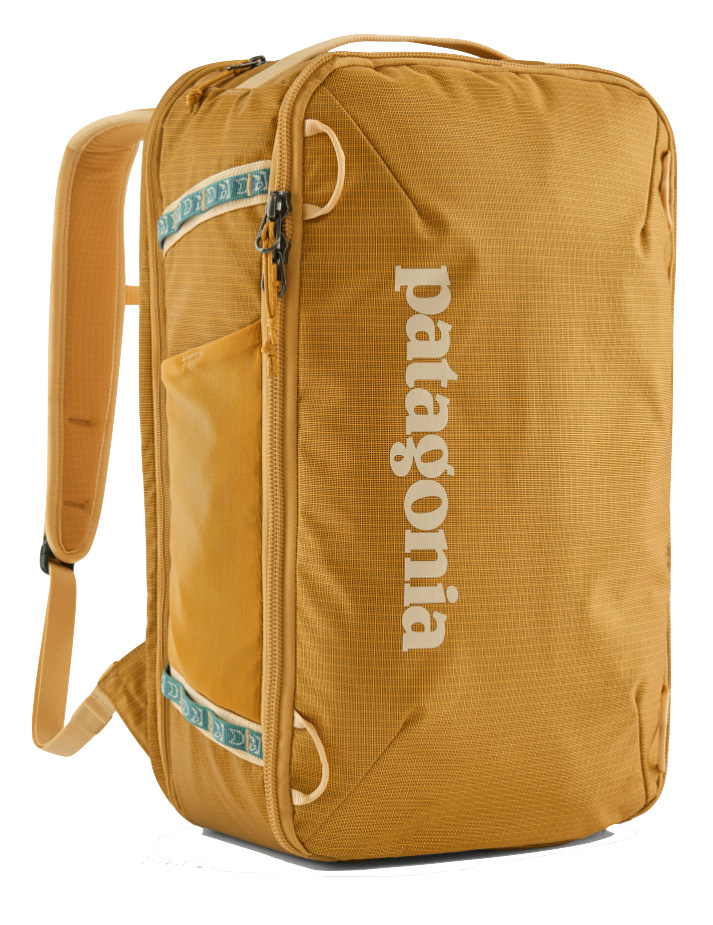 Capacity: 30L
Capacity: 30L
Dimensions: 20 x 12 x 7 in.
Weight: 2 lb. 13.5 oz.
Other size: 45L
What we like: Highly durable, good looks, and well-executed backpanel storage.
What we don’t: Limited capacity means it’s best suited for commutes or as a secondary bag for travel.
Patagonia’s Black Hole is legendary in the world of duffel bags, and the Mini MLC 30L travel pack variation shares that bag’s excellent durability and good looks in a more organized and carry-on-friendly design. Like the duffels, the Black Hole pack is made of strong (and recycled) polyester ripstop that’s highly tear-resistant with a TPU film on the exterior for fending off precipitation. It also boasts the signature daisy chain webbing along one side for securing extra gear. Importantly, however, the travel focus is clear: You get three carrying options (backpack, over-the-shoulder, or briefcase-style), compatibility with a roller bag, and a generously sized opening with two separate chambers for customizing organization.
Why do we rank the Patagonia Black Hole Mini MLC 30L here? The most glaring downside is its 30-liter capacity, which is undersized for trips lasting longer than a few days (unless you’re a staunch minimalist). Patagonia does offer a larger 45-liter variation for $40 more, although we found it to be lacking in structure, which caused the pack to feel noticeably bulky and cumbersome when stuffed full. Thankfully, both options feature the same well-executed backpanel design that we love, which comprises sleeves at one side for a laptop and tablet with zippered and drop-in pockets at the other for divvying up cords and accessories. Again, the Mini version is underbuilt for extended trips abroad but remains an excellent pick for commutes, daily use, and as a secondary bag for travel.
See the Patagonia Black Hole Mini MLC 30L
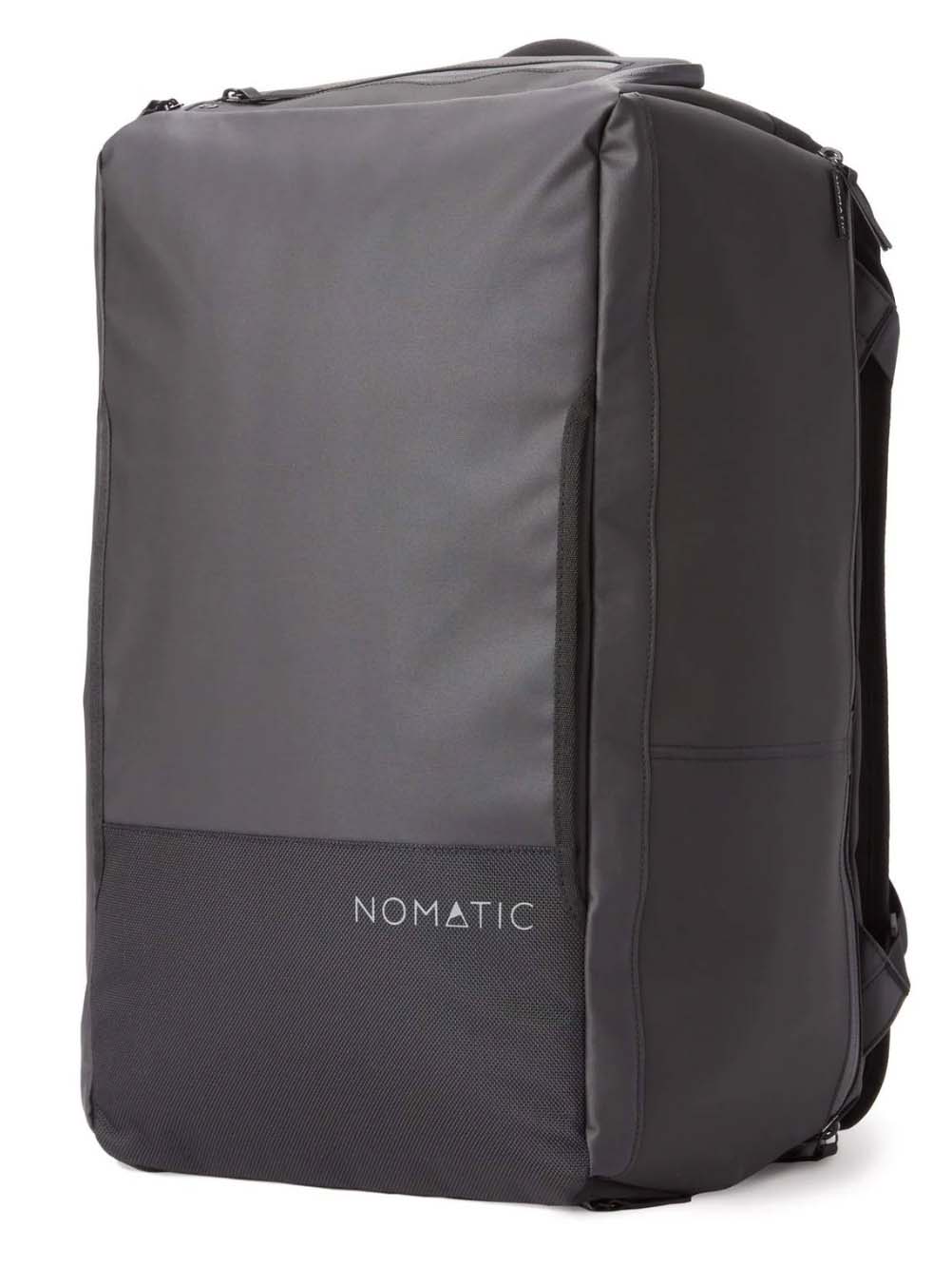 Capacity: 40L
Capacity: 40L
Dimensions: 21 x 14 x 9 in.
Weight: 3 lb. 6.7 oz.
Other size: 30L
What we like: Almost all the features we look for in a thoughtfully built travel pack.
What we don’t: Expensive and overbuilt for quick getaways; those with smaller frames may find the pack too big.
Many of the picks above are built by reputable backpacking manufacturers, but Nomatic is a travel company first. Their Travel Bag 40L embodies that focus, combining thoughtful organization and storage with easy access in a sleek and minimalist package. Feature highlights include a customizable strap design that allows you to easily alternate between backpack and duffel carry, dedicated compartments for shoes and clothing at the top and bottom of the bag, and even a mesh laundry bag to keep dirty clothes separate during travel. We also love the exterior pocket at the right side, which opens wide for easy access and features an array of mesh, fleece-lined, and zippered spots to organize electronics and cords, along with an RFID pocket for passports and other scannable documents. All told, it’s clear that Nomatic put a ton of thought into the design.
It’s worth noting that Nomatic offers another intriguing option in their Navigator, although we consider the Travel Bag the more competitive all-around design. In parsing out the differences, the Travel Bag costs $110 less and is lighter by nearly 2 pounds, although it forgoes the Navigator’s expandable main compartment that allows you to alternate between 32 and 41 liters depending on your storage needs. The Navigator also includes load lifter straps and a sculpted foam backpanel for a boost in carrying comfort, but the Travel Bag is no slouch. And from a features perspective, we appreciate the Travel Bag’s dirty shoe compartment and included laundry bag. Those with smaller frames may have trouble dialing in a secure fit—our female tester (5’6” and 135 lb.) maxed out the Travel Bag’s hipbelt, for example—but the intentional organization layout and travel-ready feature set are undeniable selling points.
See the Nomatic Travel Bag 40L
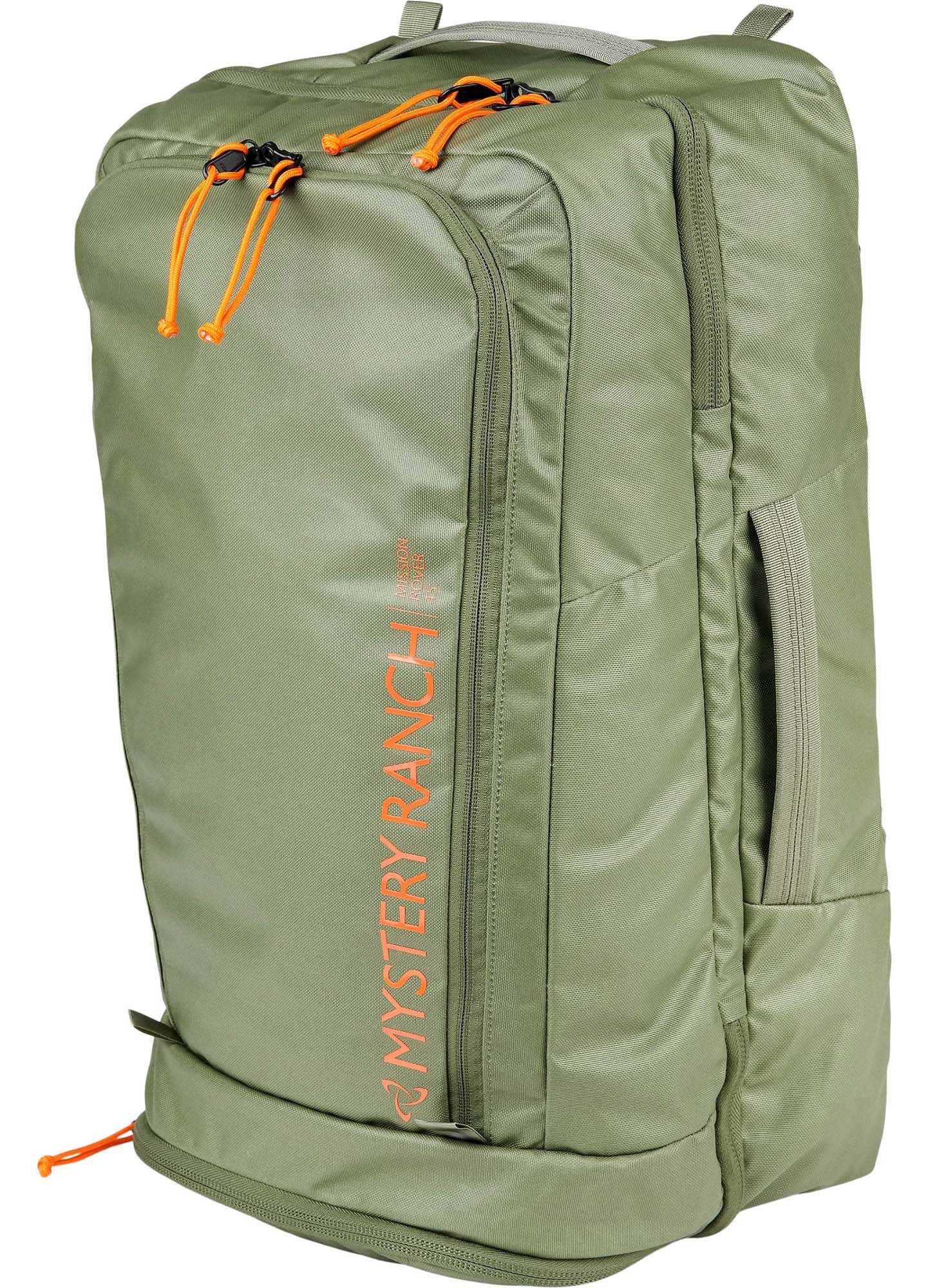 Capacity: 45L
Capacity: 45L
Dimensions: 21 x 13 x 12 in.
Weight: 3 lb. 14.4 oz.
Other sizes: 30, 60L
What we like: Robust fabrics, multiple carry options, and nicely divided interior.
What we don’t: A little pricey for what you get and not a standout in any one area.
Along with Osprey’s Sojourn Porter 46 above, Mystery Ranch’s Mission Rover 45 is a great option for those of us who aren’t particularly adept at packing light. Touted as a “do-it-all pack,” the Mission Rover offers three functional carry options (as a suitcase, shoulder bag, or standard backpack), has a well-organized main compartment with zippered dividers and a wraparound clamshell opening, and even includes a separate area for shoes or dirty laundry. As expected at this price point, you also get most of the standard travel-ready features that we look for, including stowable straps, lockable zippers, a sleeve to secure to a rolling suitcase, and a padded laptop space that can accommodate computers up to 15 inches wide. Finally, like many of Mystery Ranch's backpacking offerings, the Mission Rover has a premium feel with a thick nylon exterior and confidence-inspiring components throughout.
However, as with the Pacsafe EXP45 above, the Mission Rover’s laptop sleeve is situated at the front of the pack, which detracts from carrying comfort and convenience. The Mystery Ranch is also on the heavier and pricier end of the spectrum at 3 pounds 14.4 ounces and $249, although the 45-liter capacity is undeniably generous (and the pack is still compliant with most carry-on size restrictions). Finally, the bag is relatively dated-looking and lacking in modern appeal compared to offerings from Topo Designs, Peak Design, Cotopaxi, and others above. In other words, the Mission Rover doesn’t stand out in any one area (hence our ranking), but it’s another durable travel pack with a nicely executed feature set.
See the Mystery Ranch Mission Rover 45
| Travel Pack | Price | Capacity | Dimensions | Weight | Carry on?* | Other sizes |
|---|---|---|---|---|---|---|
| Cotopaxi Allpa 35L | $225 | 35L | 22 x 12 x 10 in. | 2 lb. 15.0 oz. | Yes | 28, 42L |
| Peak Design Travel Pack | $300 | 45L | 22 x 13 x 9.5 in. | 4 lb. 8.0 oz. | Yes | 30L |
| Amazon Basics Carry-On | $55 | 40L | 21.5 x 15.75 x 8.25 in. | 3 lb. 10.2 oz. | Yes | None |
| Osprey Sojourn Porter 46 L | $195 | 46L | 18 x 15.75 x 12.2 in. | 3 lb. 7.2 oz. | Yes | 30, 65L |
| Topo Global Travel Bag 30L | $199 | 30L | 20 x 12.5 x 7 in. | 2 lb. 10.0 oz. | Yes | 40L |
| Osprey Farpoint 70 | $230 | 70L | 25.6 x 15 x 12.6 in. | 5 lb. 6.6 oz. | No | 40, 55, 80L |
| REI Co-op Ruckpack 40 | $159 | 40L | 23 x 15 x 9.5 in. | 2 lb. 13.0 oz. | Yes | 18, 30L |
| Gregory Border Carry-On 40 | $190 | 40L | 22 x 14 x 9 in. | 2 lb. 14.9 oz. | Yes | 30L |
| TNF Base Camp Voyager | $170 | 35L | 19.3 x 12 x 6.3 in. | 3 lb. 7.0 oz. | Yes | None |
| Yeti Crossroads 35L Backpack | $250 | 35L | 20 x 13 x 8 in. | 3 lb. 11.2 oz. | Yes | 22, 27L |
| Eagle Creek Tour 40L | $249 | 40L | 20.5 x 13 x 8.75 in. | 3 lb. 4.0 oz. | Yes | 55L |
| Tortuga Travel Pack Pro 40L | $375 | 40L | 21.7 x 13.8 x 7.9 in. | 4 lb. 8.0 oz. | Yes | None |
| Matador GlobeRider45 | $350 | 45L | 22 x 12.8 x 11 in. | 4 lb. 8.0 oz. | Yes | 35L |
| Thule Aion Travel Pack | $200 | 40L | 20.5 x 13 x 9.1 in. | 3 lb. 3.0 oz. | Yes | 28L |
| Pacsafe EXP45 | $290 | 45L | 21.7 x 13 x 7.5 in. | 3 lb. 15.5 oz. | Yes | 35L |
| Patagonia Black Hole Mini MLC | $199 | 30L | 20 x 12 x 7 in. | 2 lb. 13.5 oz. | Yes | 45L |
| Nomatic Travel Bag 40L | $290 | 40L | 21 x 14 x 9 in. | 3 lb. 6.7 oz. | Yes | 30L |
| Mystery Ranch Mission Rover 45 | $249 | 45L | 21 x 13 x 12 in. | 3 lb. 14.4 oz. | Yes | 30, 60L |
Editor's note: "Carry-on" refers to whether or not each pack meets standard domestic and international air travel restrictions, which must be under 22 x 14 x 9 inches or 45 linear inches when adding L+W+H.
True to our name, globetrotting is a big part of what we do at Switchback Travel. Managing editor Sarah Nelson put together our initial list of 16 picks in 2022 after a trip to El Chaltén in southern Argentina with fellow staff members and gear testers. From takeoff to our return flights home, we put our packs through their paces by stuffing them to the brim with two weeks’ worth of clothing and gear, schlepping them through domestic and international airports, shoving them into overhead compartments and below our seats, and getting intimately familiar with organizational layouts for divvying up our documents and electronics. Upon our return, we also evaluated each pack closely for signs of wear, like tears and stains.
Our current list of 18 picks reflects our own experiences as well as feedback from our freelancers, travel-savvy friends, and the online travel community. We continue to test travel packs on adventures near and far, adding and removing designs as the market shifts and as we get firsthand experience with more options. For example, on a trip to Chilean Patagonia in February 2024, we brought along two new-to-us travel packs: The North Face Base Camp Voyager and the Nomatic Travel Pack, both of which are now featured in the guide above. We’ll be sure to add any other standouts and favorites to the list above with each update. And for more organization options, check out our articles on the best duffel bags and best wheeled duffel bags.
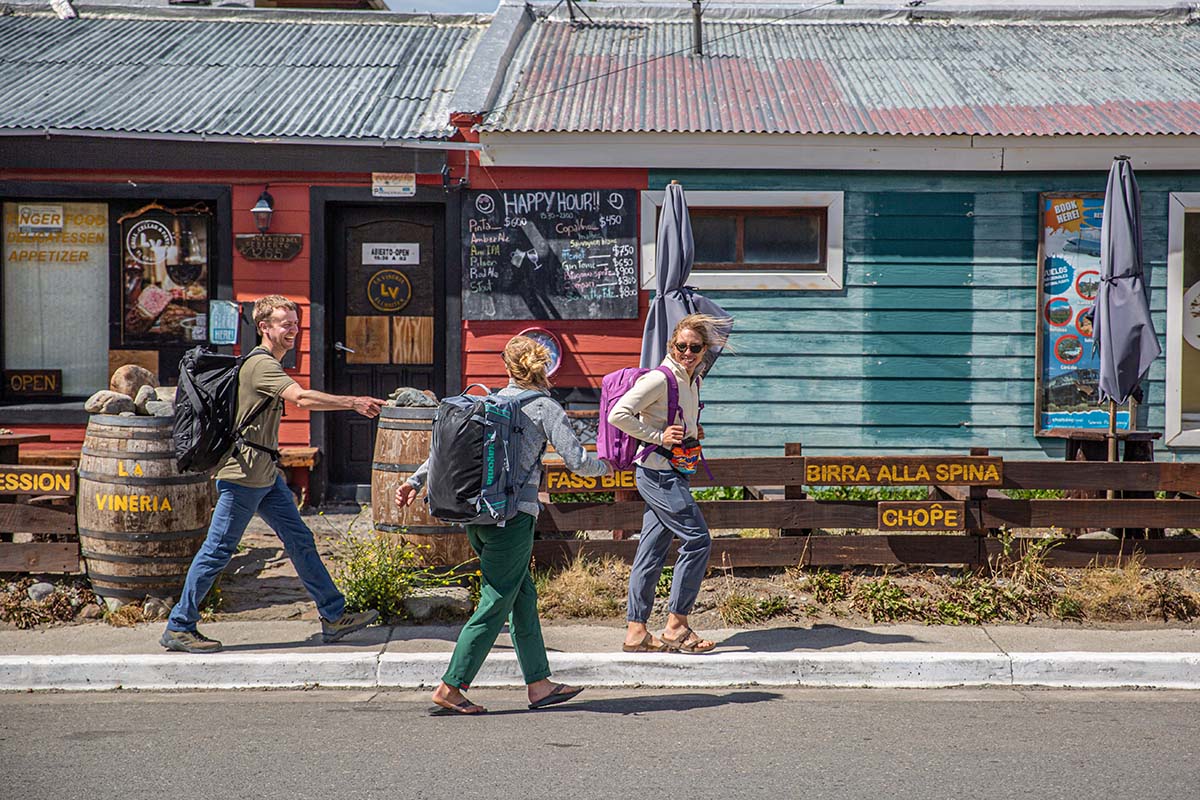
The first question to answer when choosing a travel pack is how much capacity you anticipate needing. For reference, the options above range from 30 liters on the small end (the Topo Designs Global Travel Bag) all the way up to 70 liters for the Osprey Farpoint 70 (with the 15L daypack attached). Most travelers will land on something in the middle, with the sweet spot for many being in the 40- to 45-liter range—it’s no coincidence that well over half of the models above fall into this grouping, which is largely due to their carry-on-compliant dimensions.
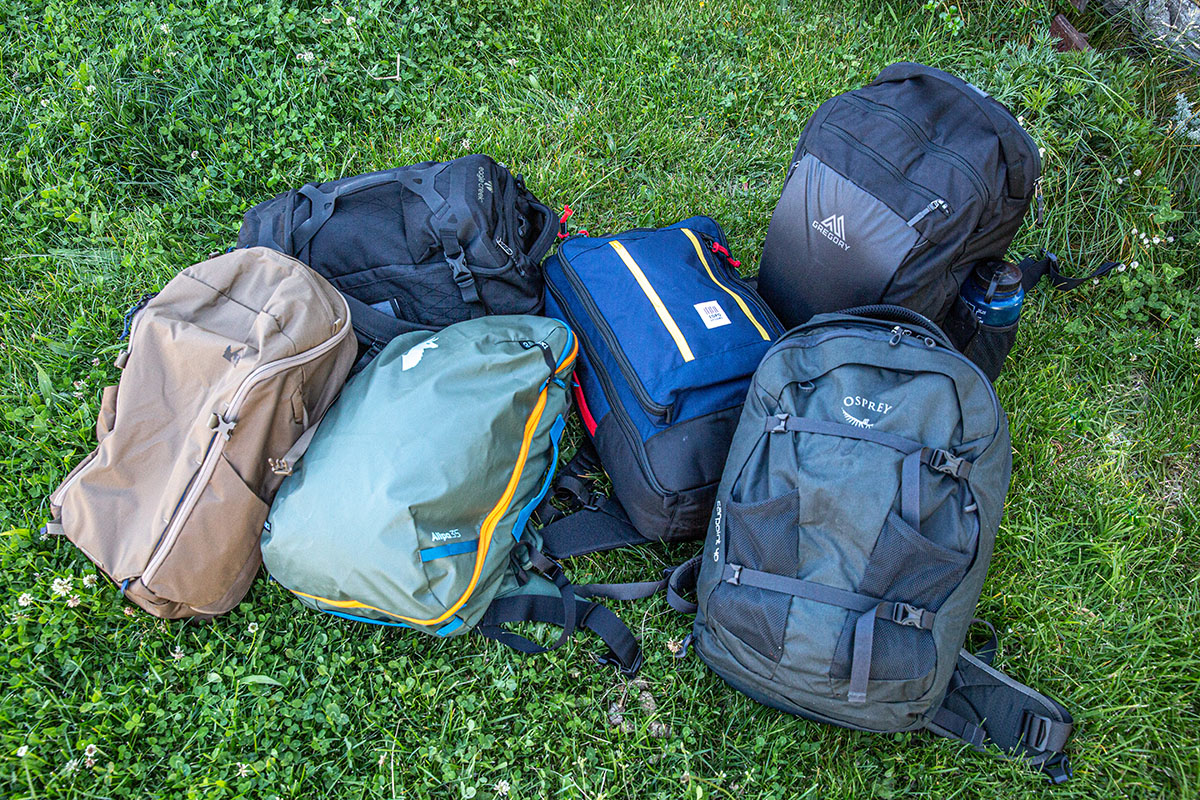
In general, we’ve found that packs of this size can easily accommodate a week or two of clothing, toiletries, and other travel accessories (and even more if you pack light). For reference, we had no issues fitting 14 days’ worth of belongings into the 40-liter version of Topo Designs’ Global Travel Bag on a recent trip to Patagonia. If you stick to weekend adventures, you can keep things lighter and more compact (and save some cash in the process) by opting for the smaller, 30-liter variation. On the flip side, those embarking on longer expeditions abroad might need to step up to a larger design like the Osprey Farpoint 70 or 80 (at the sacrifice of carry-on compatibility).
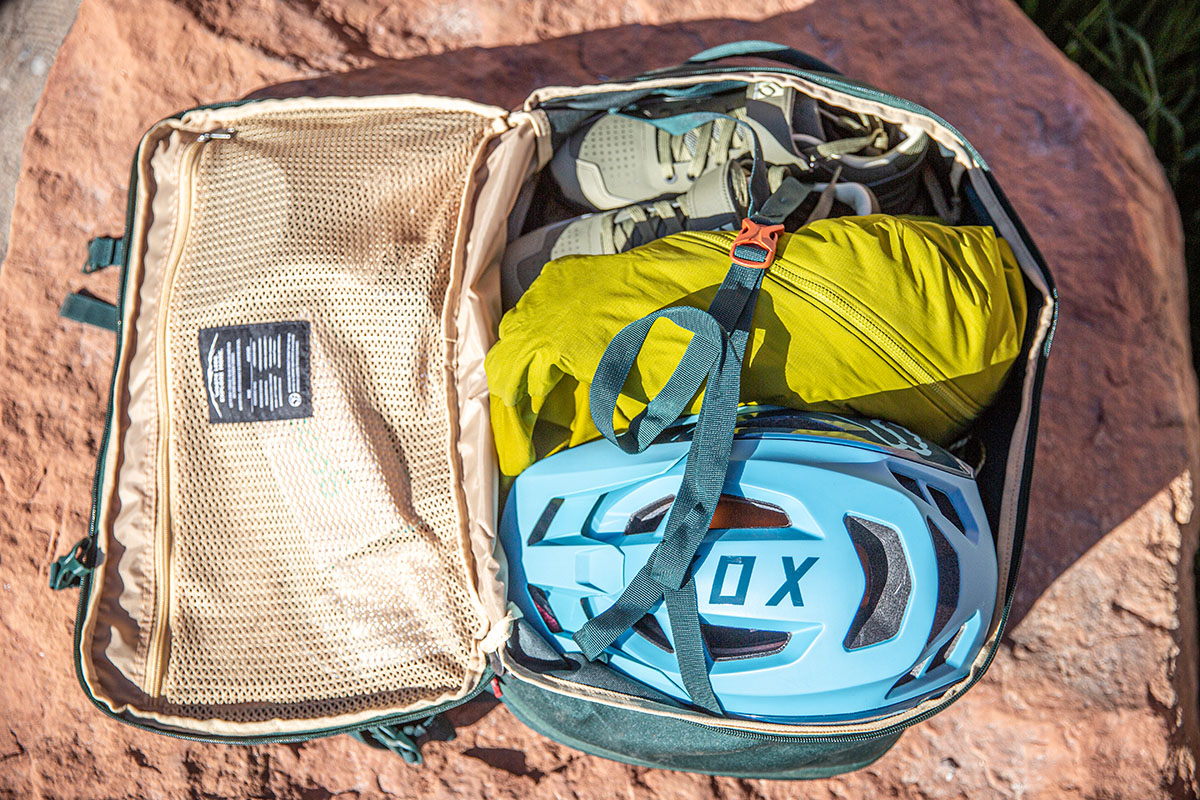
Dimensions are a crucial consideration for most travelers, and especially those headed abroad. With that in mind, we’ve listed the length, width, and height measurements for each travel pack above both in the write-ups and in our comparison table. As you may notice, similarly sized travel packs don’t vary too considerably in terms of dimensions. This is mainly due to carry-on size restrictions, which we break down more in depth below.
Carry-on Size Restrictions
Right off the bat, we’ll note that there is technically no standardized size requirement for carry-on luggage domestically or abroad. That said, the universally accepted dimensions within the U.S. are 22 x 14 x 9 inches or 45 linear inches when adding L+W+H. We’ve indicated whether each travel pack above meets these requirements in our comparison table, and REI Co-op does the same on each of their product pages. The only exception above is the Osprey Farpoint 70, which measures 25.6 x 15 x 12.6 inches.
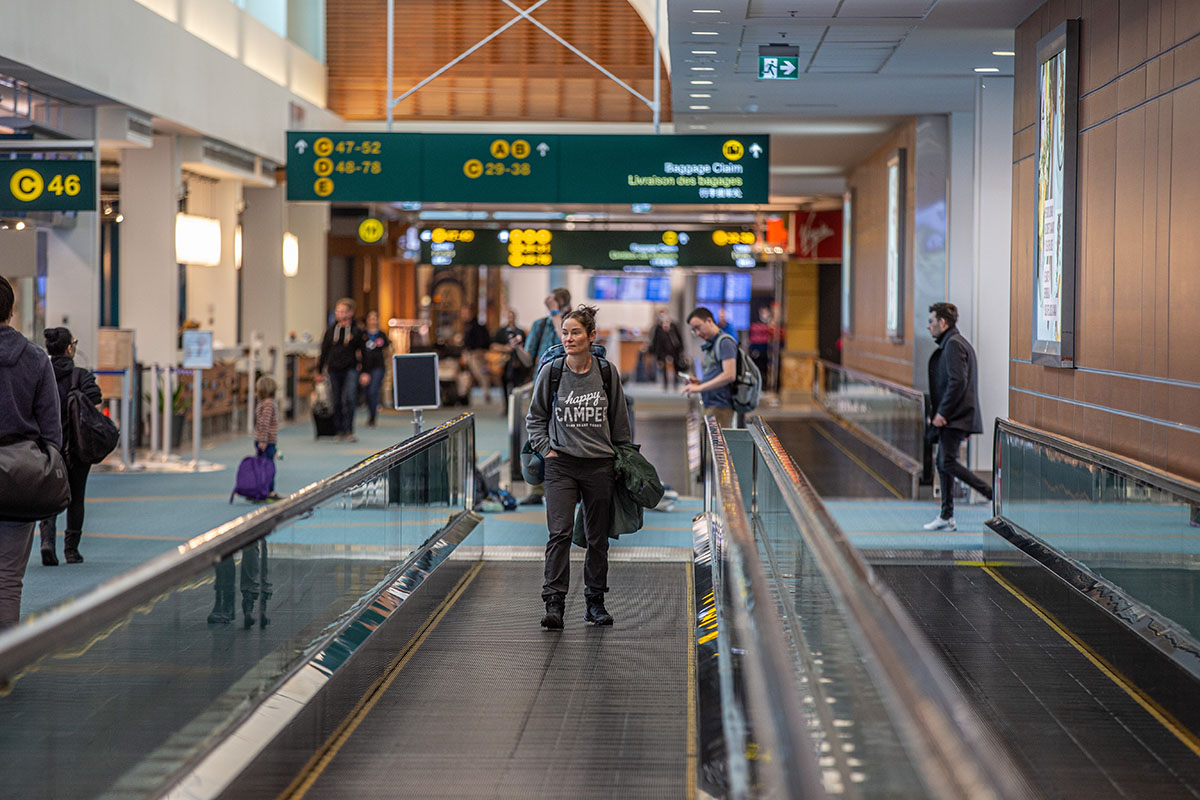
It’s also important to call out expandable models here like the Peak Design Travel Backpack, which is carry-on compliant when compressed to 35 liters (22 x 13 x 9.5 in.) but not when expanded to its maximum 45-liter capacity (22 x 13 x 11 in.). You may be able to get away with carrying these bags onboard, but don’t count on it, especially if you’re traveling during peak season to a popular destination. When in doubt, you can always check with your airline ahead of time.
All of the packs above are purpose-built for travel with extensive organizational layouts and thoughtfully placed pockets for separating valuables, electronics, and other accessories. That said, some layouts are more functional than others, and a final decision will largely come down to your intended use and what works best for the items that you plan to bring along. For instance, sleek options like the Peak Design Travel Pack and Nomatic Travel Bag are great for digital nomads and remote workers who need to organize a lot of electronics, while backpacking-inspired designs like Osprey’s Farpoint and Sojourn Porter offerings have fewer tech-focused features but work great for adventure travel. We break down some of the key organizational components below, from laptop and tablet sleeves to water bottle storage and pack opening styles.
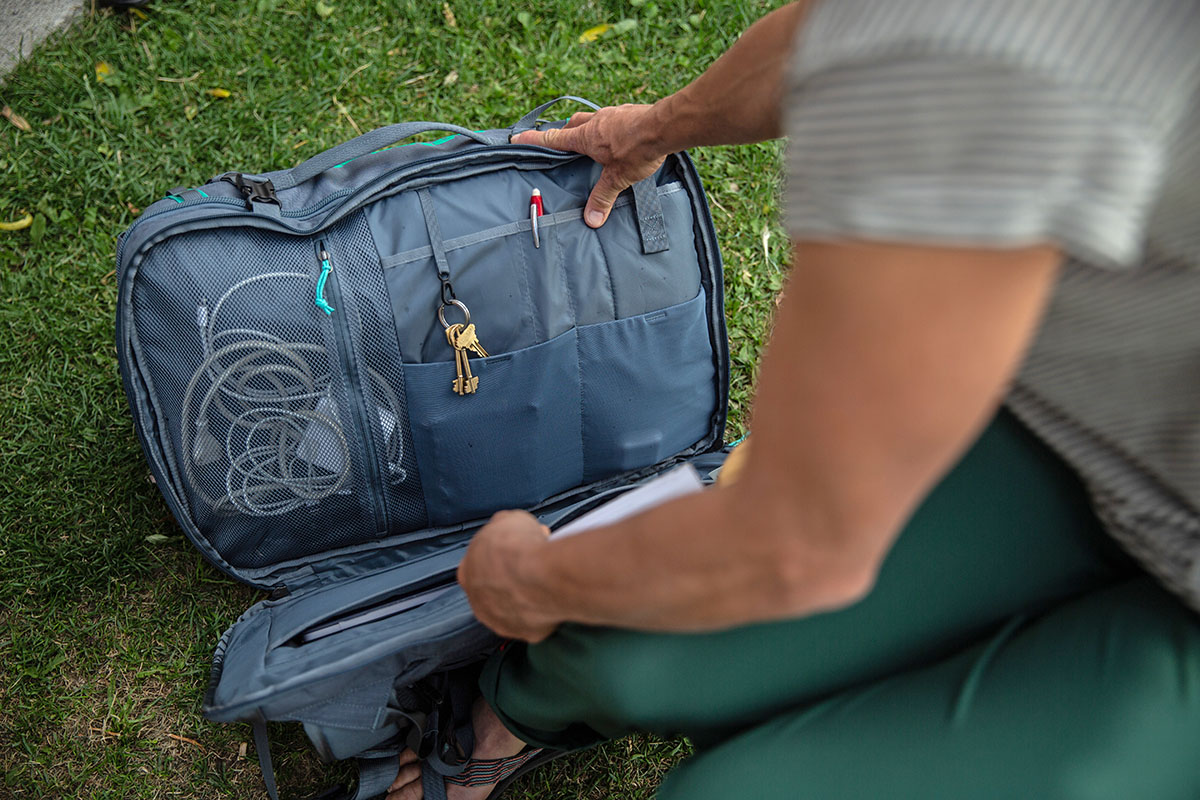
Laptop and Tablet Sleeves
Laptop storage is a requisite feature in a travel pack, and all of the picks above come with a dedicated spot to stash larger electronics. In terms of dimensions, most sleeves can accommodate up to a 15-inch laptop, and many come with separate smaller compartments in the same space for a tablet, too. This area is typically well padded to protect electronics and positioned along the backpanel for the best access and weight distribution (keeping heavier items closest to your back will help maximize comfort and balance). A couple exceptions to this rule are the Pacsafe EXP45 and Mystery Ranch Mission Rover 45, both of which have the laptop sleeve at the front of the pack and can feel a little less well balanced with heavier electronics situated farther away from your body.
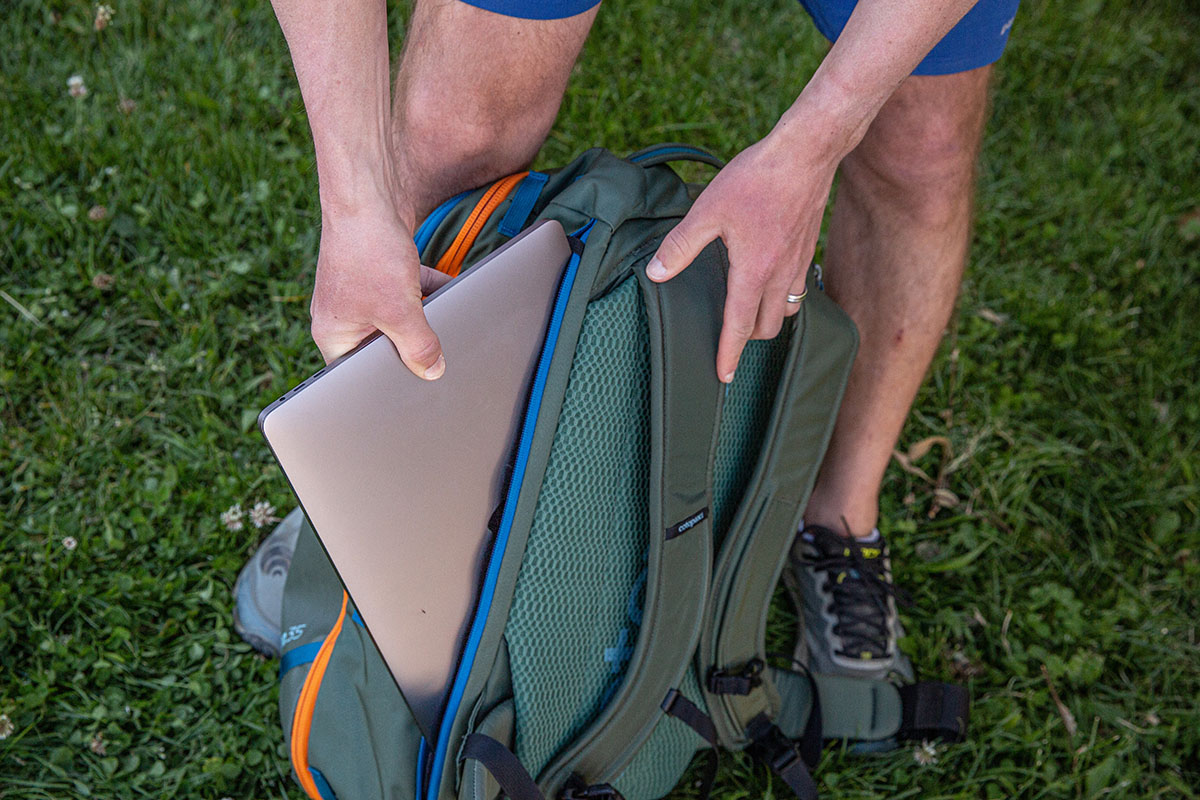
Water Bottle Pockets
Side water bottle pockets are becoming increasingly common on travel packs, and we utilize them frequently on domestic and international trips alike. In fact, most of the models above include water bottle pockets, with the exception of the budget-friendly Amazon Basics Carry-On. It’s worth noting that a couple options can also accommodate hydration reservoirs: The REI Co-op Ruckpack 40 has a bladder-friendly sleeve that doubles as laptop storage (along with an access port at the top for a tube), while the Osprey Farpoint’s removable daypack has a similar dual-purpose design.
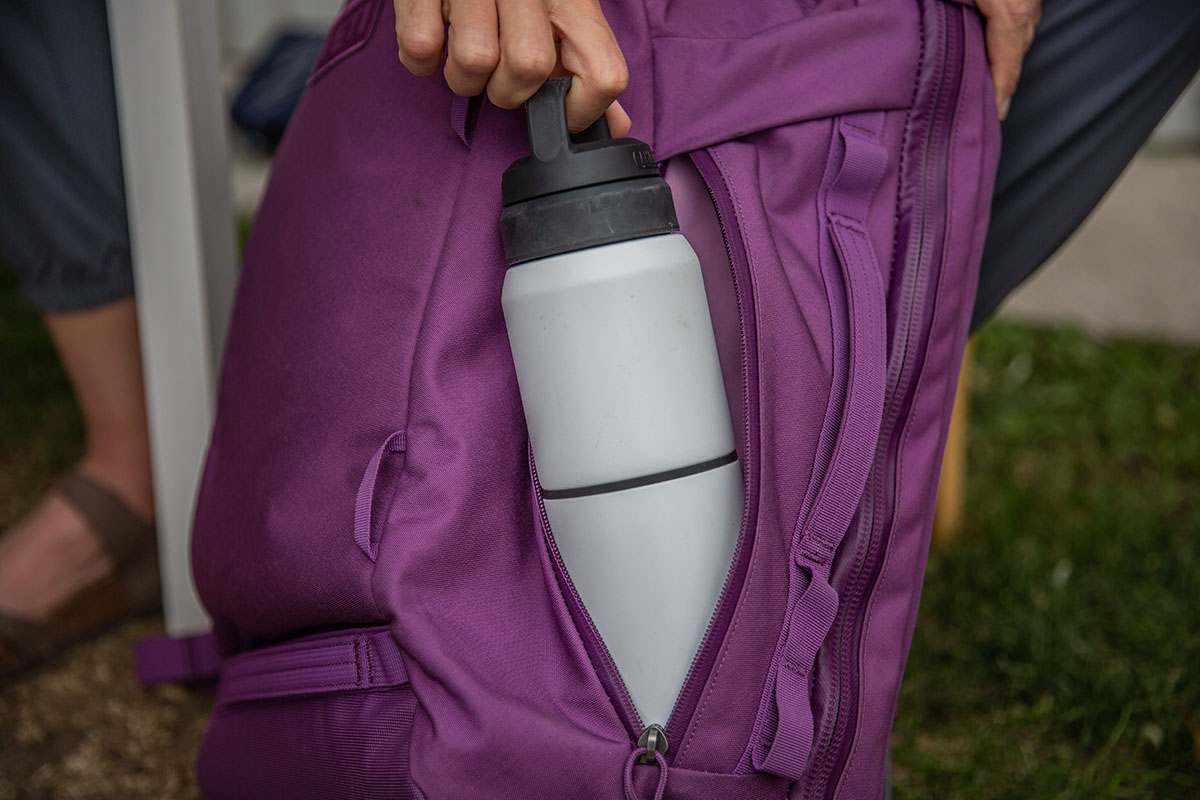
Opening Styles and Access
Easy access is a hallmark of a good travel backpack. The clamshell-style opening is far and away the most popular design and for good reason: With the pack laid flat, you can easily see and access the entirety of the main compartment. Some backpack-inspired designs, like Osprey's Sojourn Porter 46 and Farpoint 70, utilize generous U-zip designs instead, which are pretty functional but make it a little harder to reach contents at the very bottom of the bags. Finally, it's important to note that some bags come with multiple access points, which can be a nice feature for accessing your belongings while on the move.
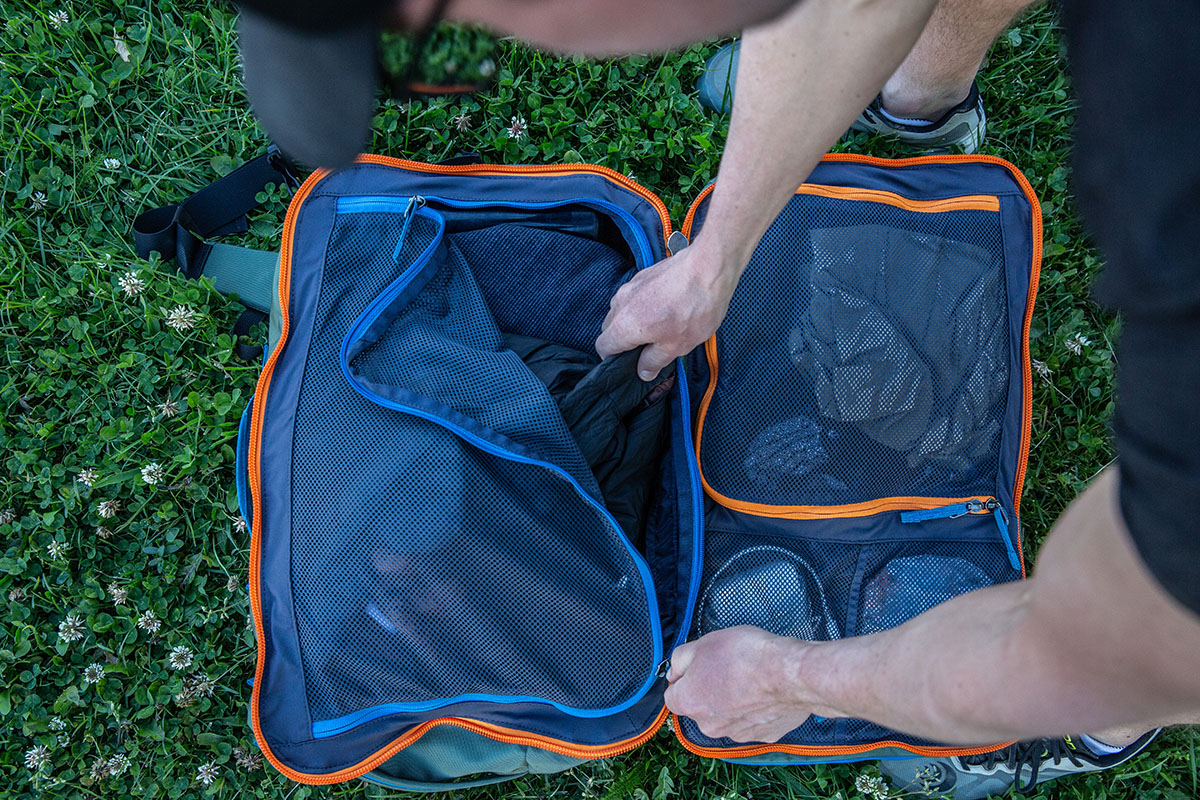
Comfort can be somewhat subjective, but a few features help certain travel packs stand out from the rest of the market. Typically, the most comfortable designs boast shoulder straps and hipbelts with thick padding and good adjustability for dialing in fit. Sternum and load-lifter straps can also be very helpful in effectively distributing a heavy load. One brand that stands out in this area is Osprey, which makes sense given their expertise in the backpacking pack market. One of our favorite options for shuttling heavy loads over long distances is Osprey Sojourn Porter 46, which features thick cushioning and good adjustability at the shoulders and waist belt and comes with load lifters for bringing the weight closer to your back.

On the flip side, models without hipbelts are generally the least comfortable, especially when wearing them for extended stretches. From the list above, only the Thule Aoin doesn’t come with one, although their Aion sling bag (sold separately for $50) can be attached to serve as a hipbelt. Thin webbing designs—like what you get with the Amazon Basics Carry-On and Yeti Crossroads—aren’t much better, providing very little support and structure for keeping the weight of the pack on your hips (rather than your back). If you plan to be walking long distances with your pack through airports or city streets, we consider a well-padded waist belt a critical feature and worth the added investment.
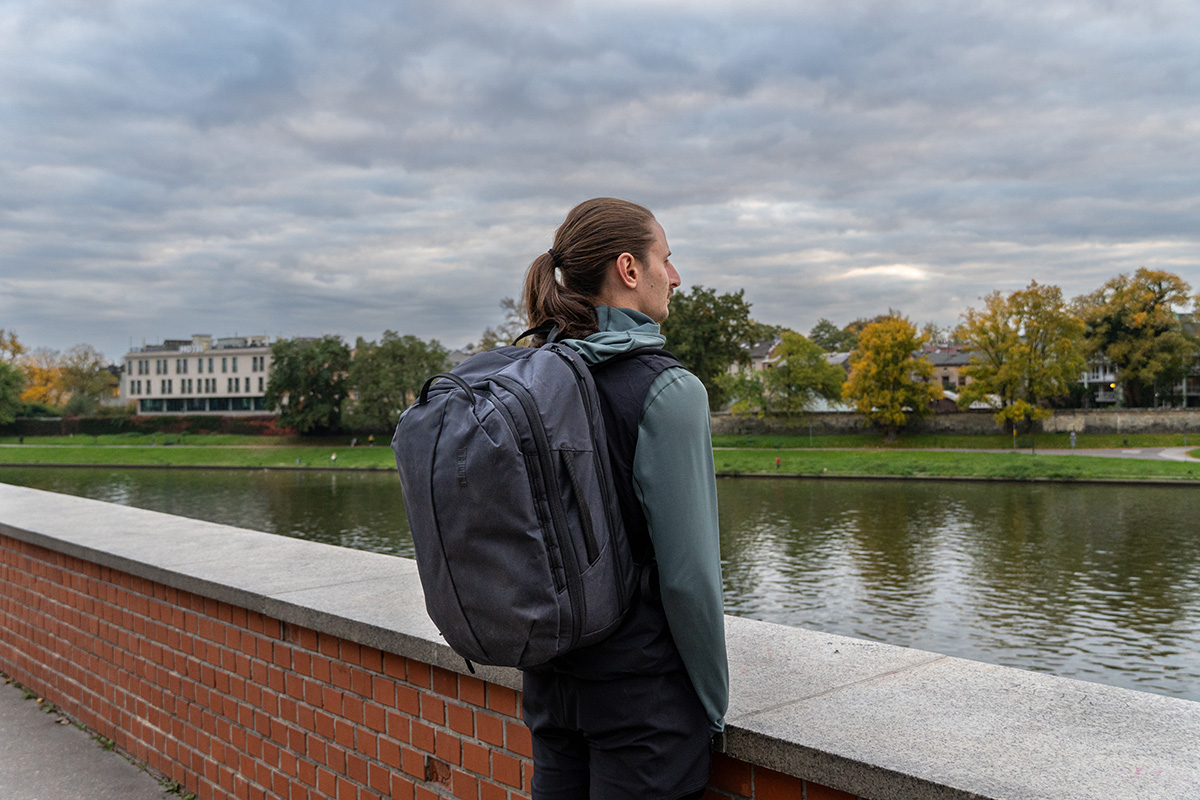
The models above are designed to be worn on your back as backpacks, but many travelers appreciate the ability to carry their pack suitcase-style or over the shoulder. These options are especially helpful when standing in line to check in at the airport or retrieve travel documents. For instance, the Peak Design Travel Pack boasts 360-degree grab handles that make it quick and easy to take the pack off and carry it one-handed through security checkpoints or narrow airplane aisles. Designs like the Topo Designs Global Travel Bag 30L also come with detachable straps for shoulder carry, which can be helpful when you need to access items inside but want to keep the pack off the ground and remain hands-free. Finally, many of the offerings here can be secured to a roller bag via pass-through sleeves, which we cover more below.
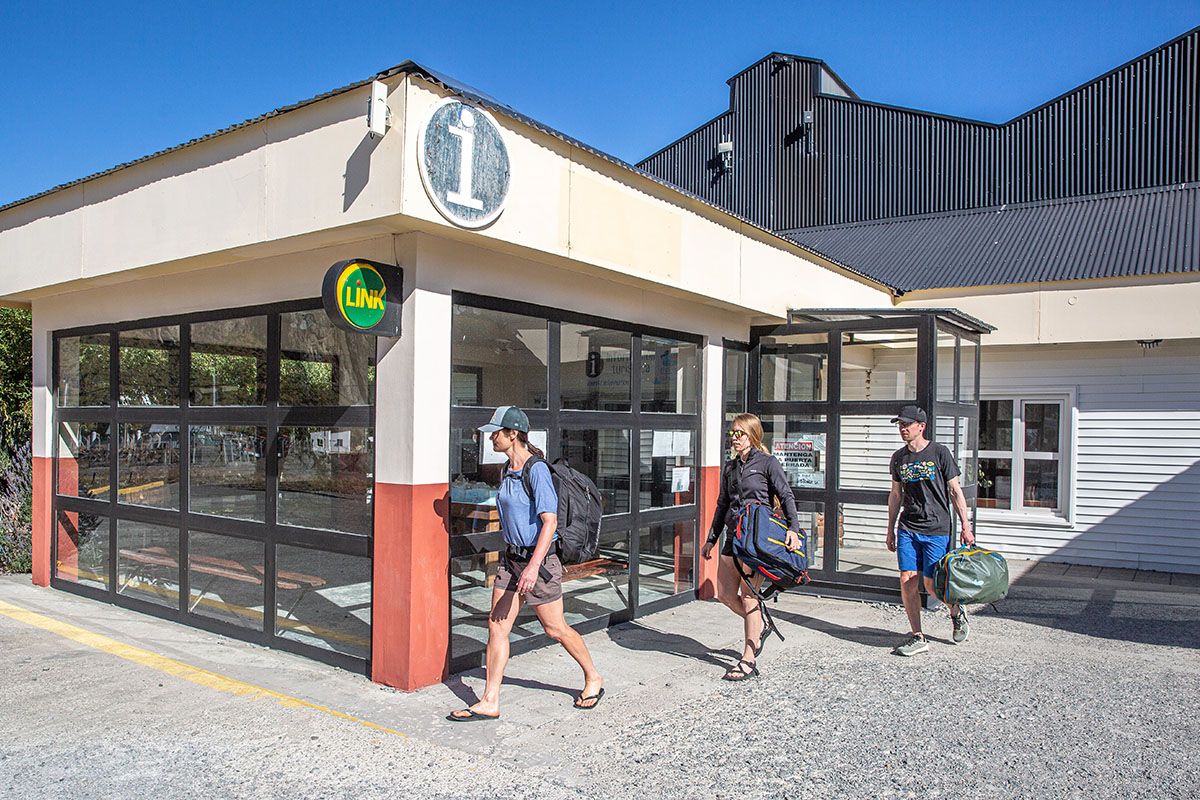
In addition to pockets and electronics sleeves, there are a few other features specific to travel packs that are worth having on your radar. Lockable zippers are fairly standard at the mid to upper end of the market (budget designs like the Amazon Basics Carry-On Travel Backpack forgo them), as are removable and/or stowable straps and compression straps or dividers to keep things tidy in the main compartment. As is common with backpacking models, some travel packs also come with built-in rain covers that stow away when not in use, including the REI Co-op Ruckpack 40. Finally, many will appreciate the ability to attach their travel pack directly to a rolling suitcase via a pass-through handle or sleeve (like what you get with Yeti Crossroads 35L and many others above).
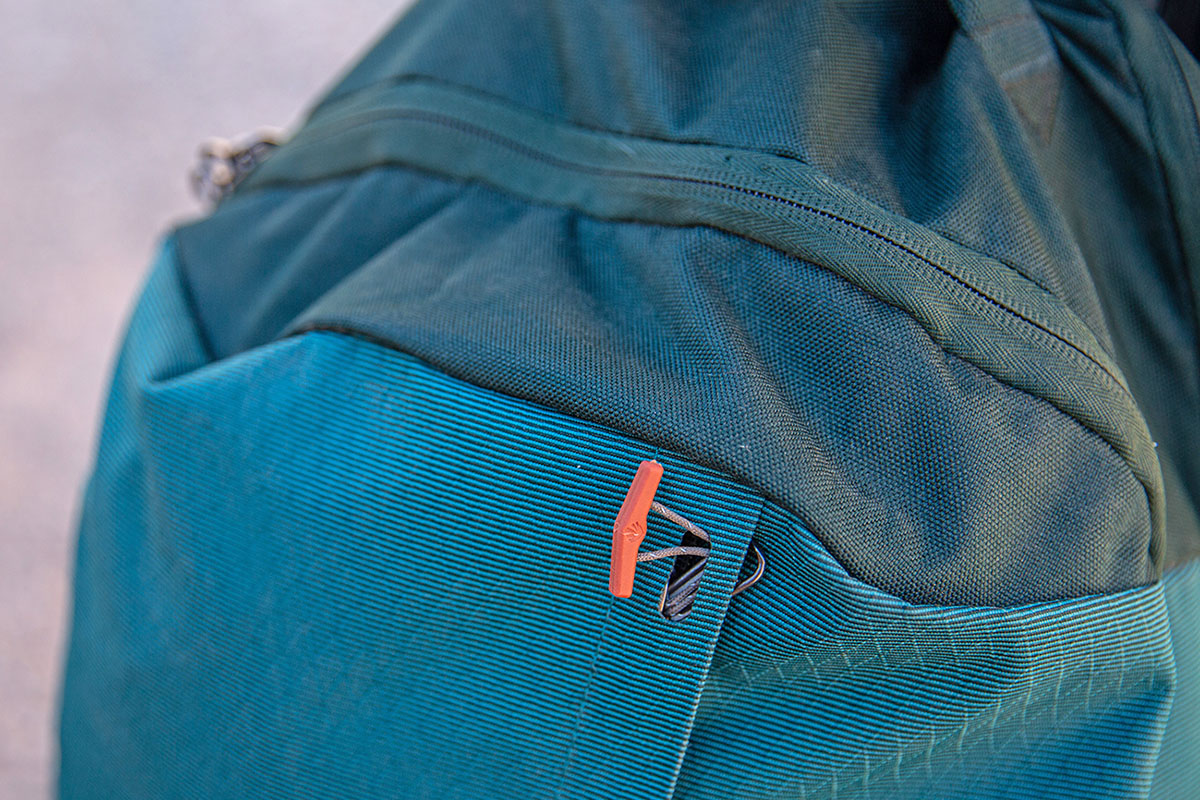
Given the inherently rough nature of travel, all of the packs above are well built and hardwearing enough to withstand frequent use. That said, some are certainly more durable than others, and looking at denier (a measurement of fabric thickness) can help differentiate between models. For instance, the Gregory Border Carry-On 40 is pretty average with a mix of 210D and 450D materials, while the Topo Designs Global Travel Bag is one of the thickest and most abrasion-resistant options on our list with a combination of 1,000D nylon and 1,680D ballistic nylon. Pacsafe’s EXP45 is another standout, with stainless steel wire mesh built into the 750D polyester body to guard against theft. At the thinner end, Matador’s GlobeRider45 uses a mix of mostly 100 and 420D fabrics, although the nylon body is coated with a PU laminate to boost weather and abrasion resistance, and Matador included reinforcements in high-wear areas.
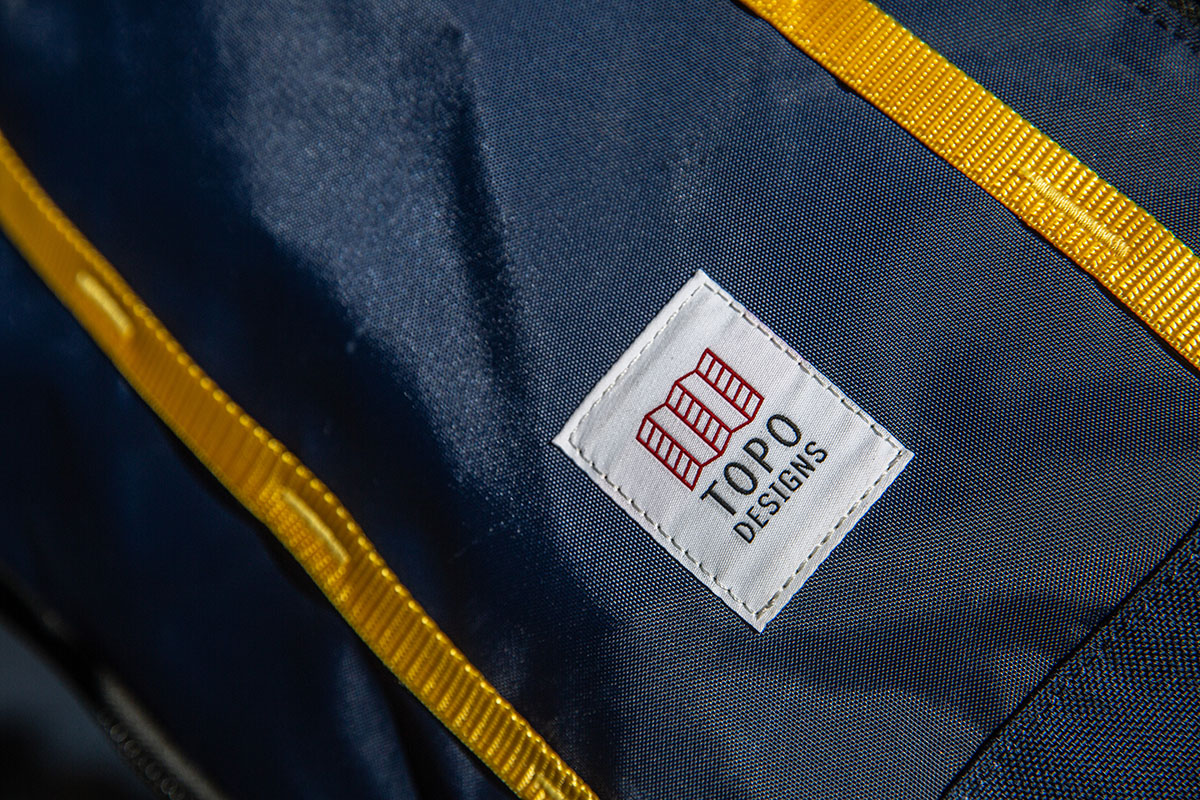
Other durability-related additions to keep an eye out for are thick padding along the interior to promote structure and protect your belongings, weather-resistant details like YKK zippers and DWR coatings on the outside to fend off precipitation, and thicker materials at the base to help protect the pack when you set it down. And we should note here that cost often correlates pretty closely with overall quality. In other words, a budget pack like the Amazon Basics Carry-On Travel Backpack feels noticeably cheaper than most other options above and will likely wear down far more quickly. If you’re a frequent traveler, it’s almost certainly worth investing in a pricier and more premium option that will last.
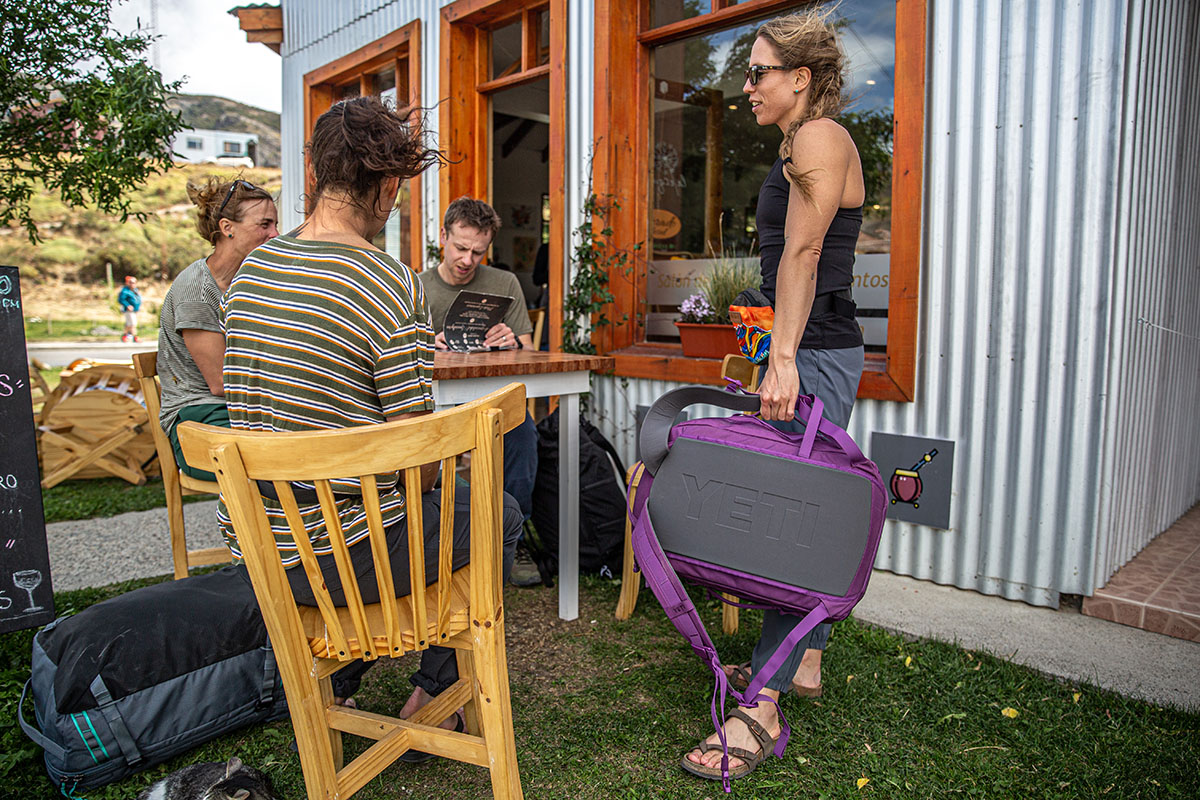
The weight spread isn’t huge among travel pack designs, but even a 1-pound difference may still be noticeable during long treks across town or the airport. For reference, the lightest option on our list is Topo Designs’ Global Travel Bag 30L (2 lb. 10 oz.), while the Osprey Farpoint 70 is the heaviest at 5 pounds 6.6 ounces. Most models fall somewhere in the middle, with the majority of 40- to 45-liter designs hovering somewhere between 3 and 4.5 pounds. In the end, weight won’t be a primary consideration for many travelers, but those backpacking through Europe or expecting to cover serious ground will probably want to shop toward the lighter end.
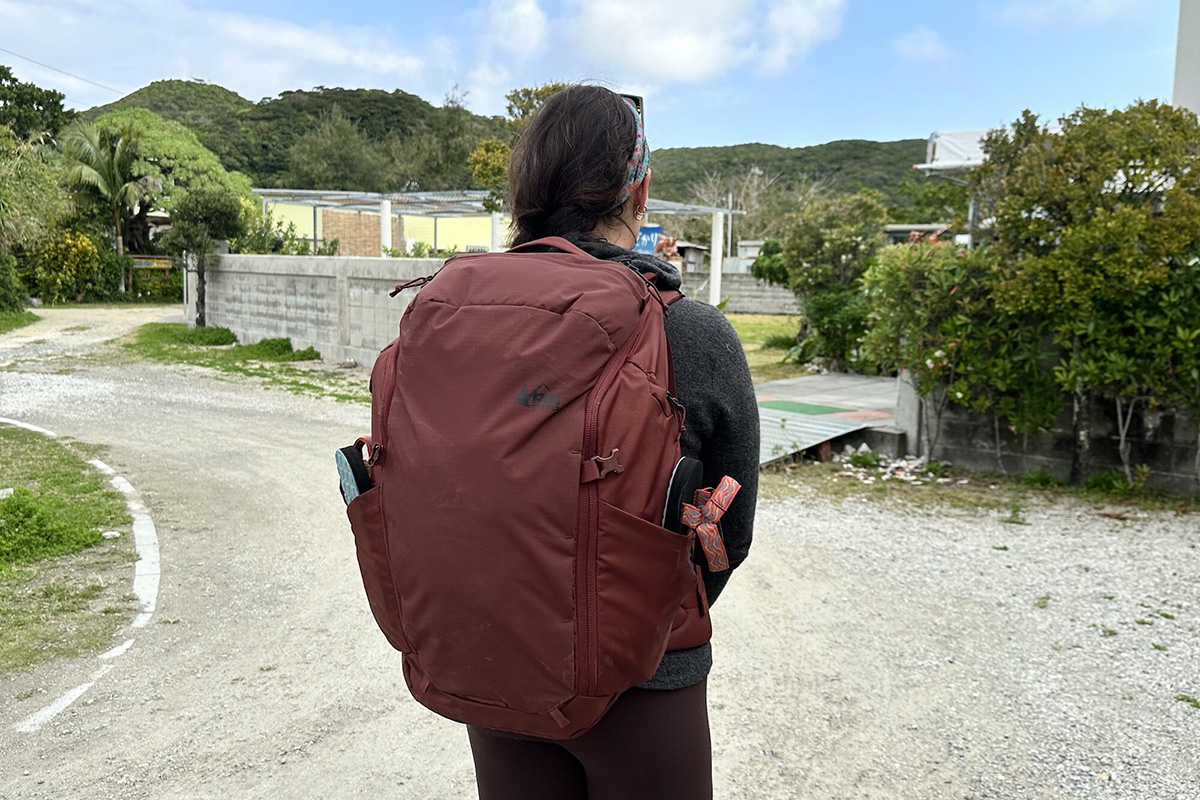
Unlike their backpacking pack counterparts, travel packs are most often only offered in a single unisex option. This can make it difficult to dial in fit, especially for those with particularly narrow or broad builds. One exception above is the REI Co-op Ruckpack 40, which is offered in both men’s and women’s versions, each of which come in two sizes. Regardless of which option you choose, we always recommend trying on multiple packs before buying to see which fits you best (or at least purchasing from a reputable manufacturer with a generous return policy). You’ll want to be sure that you can adjust the shoulder straps and waist belt to be snug around your torso and waist. Sternum straps and load lifters can also be helpful for bringing the load closer to your back to maximize comfort and weight distribution.
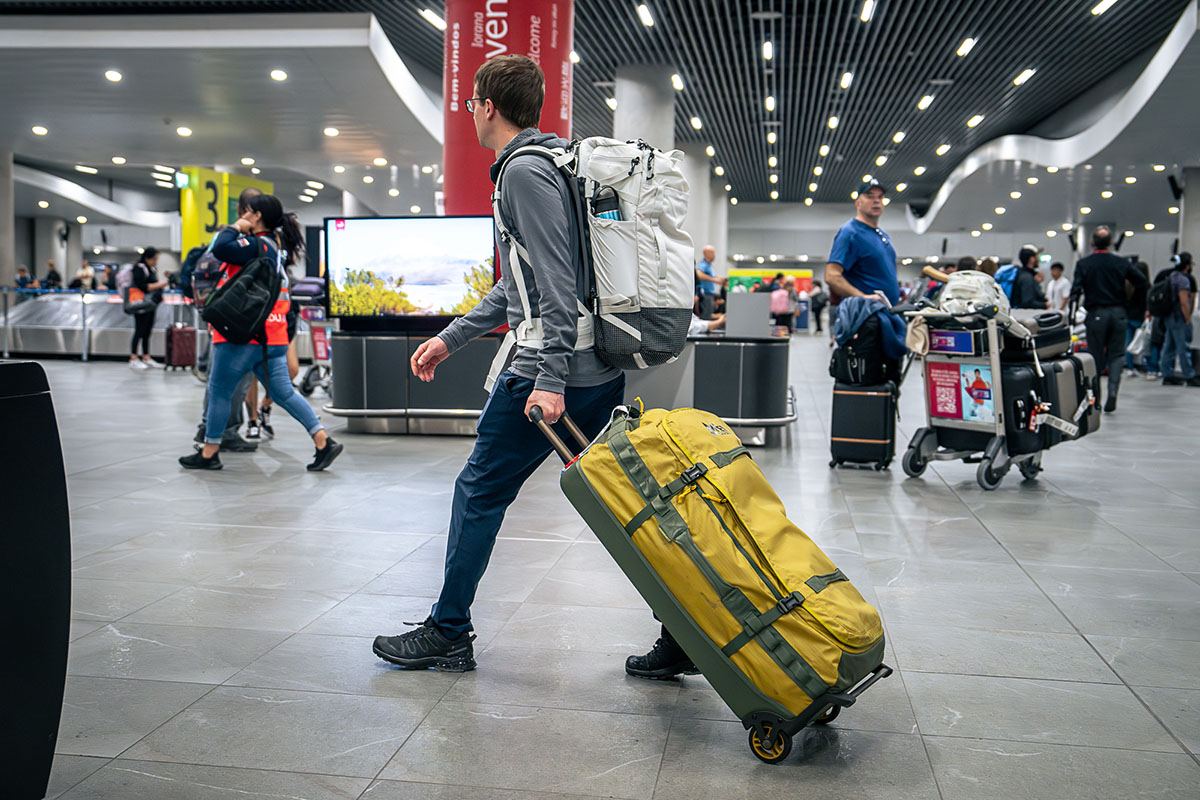
As we mentioned above, most travel packs are unisex by design. In fact, only two models on our list are offered in women’s-specific versions: the Osprey Fairview (the Farpoint’s counterpart) and REI Ruckpack 40. Key differences include varying colorways, minor weight variations, and slightly smaller torso and waist measurements. The Fairview also has more contoured shoulder straps and a curved hipbelt to better conform to narrower torsos/shoulders and larger hips, although the packs share an otherwise identical overall construction and feature set. Regardless of designation, we always recommend choosing the pack that fits you best.
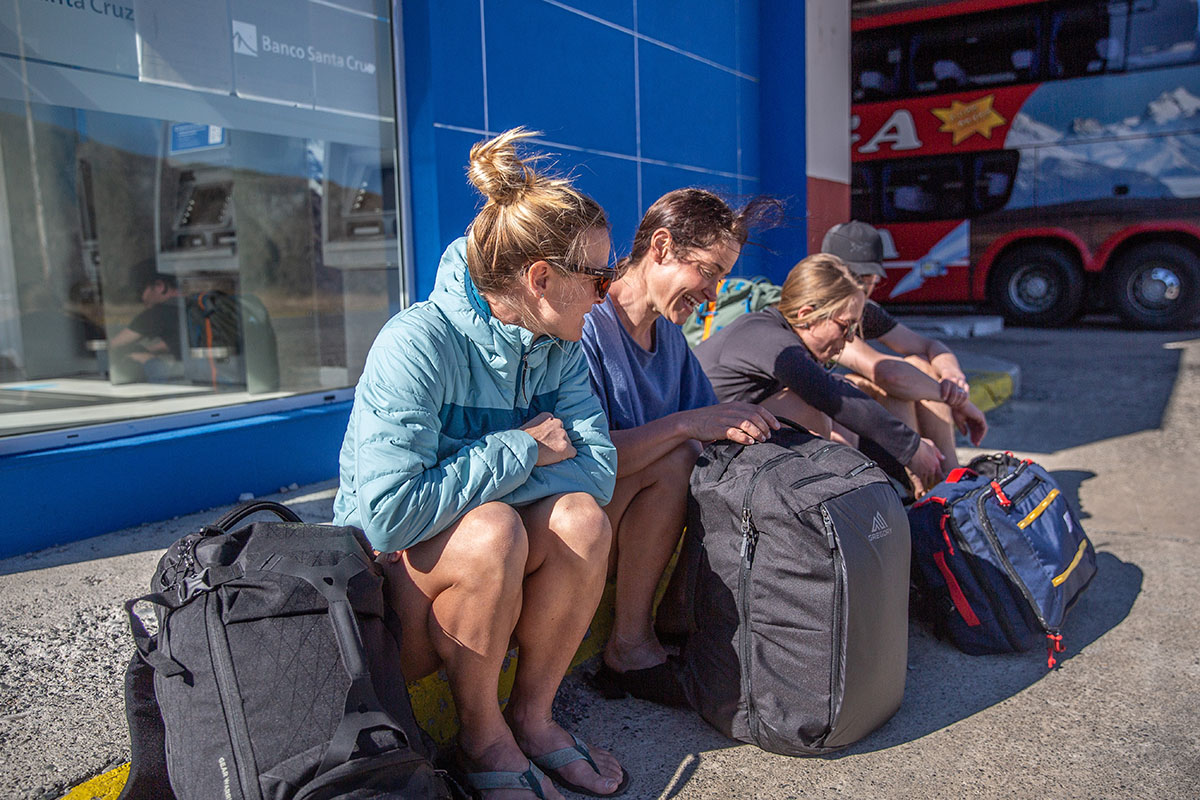
In 2025, it’s pretty common to see pack manufacturers incorporating eco-friendly practices into production, including measures like recycled and bluesign-approved fabrics and PFAS-free DWR coatings. A couple examples include Pacsafe’s Venturesafe EXP45, which uses polyester that's made from recycled water bottles and other plastics, and Patagonia’s Black Hole Mini MLC 30L, which uses recycled and bluesign-approved (i.e., environmentally safe) polyester and is certified to the Fair Trade standard. A final feature to look out for is a PFAS-free DWR coating, which forgoes the use of per- or polyfluorinated chemicals—"forever chemicals" known to be harmful to the environment. With many states stepping up to ban the sale of items that include PFAS, the outdoor industry is seeking better solutions for water- and stain-resistant finishes (for more, you can read about Patagonia’s take on the issue).
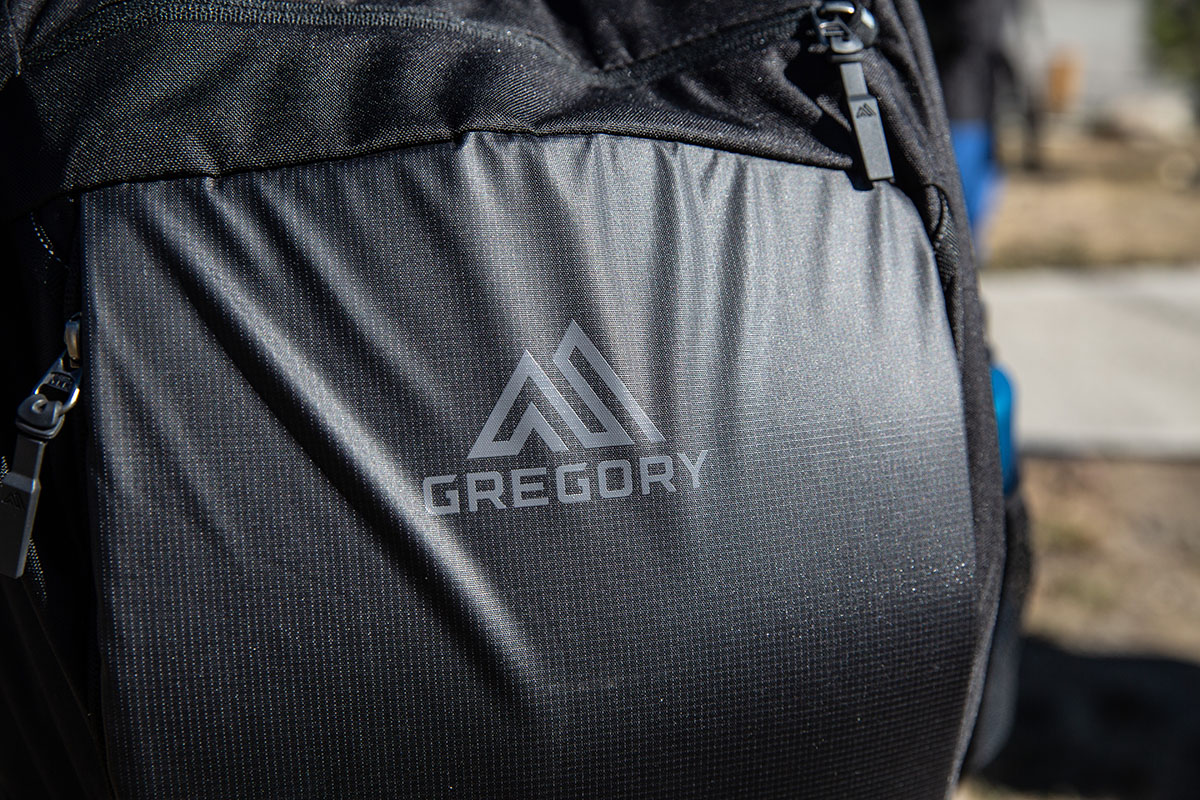
Packing your travel pack can often feel like playing a hard game of Tetris, especially for those of us who aren’t great at traveling light (this author included). To help, many of the brands above offer compatible accessories for their packs, from packing cubes to protective hard cases for electronics and more. Importantly, these add-ons are often modular and fit neatly into the main compartment of a compatible backpack. Some of our favorites include Topo Designs’ Pack Bags, Peak Design’s Packing Cubes and Tech Pouches, and Eagle Creek’s Pack-It compression cubes. In the end, these accessories aren't a necessary purchase for many travelers (and you certainly don't need to buy them from the same manufacturer as your pack), but they can go a long way toward maximizing organization and space and streamlining your load.
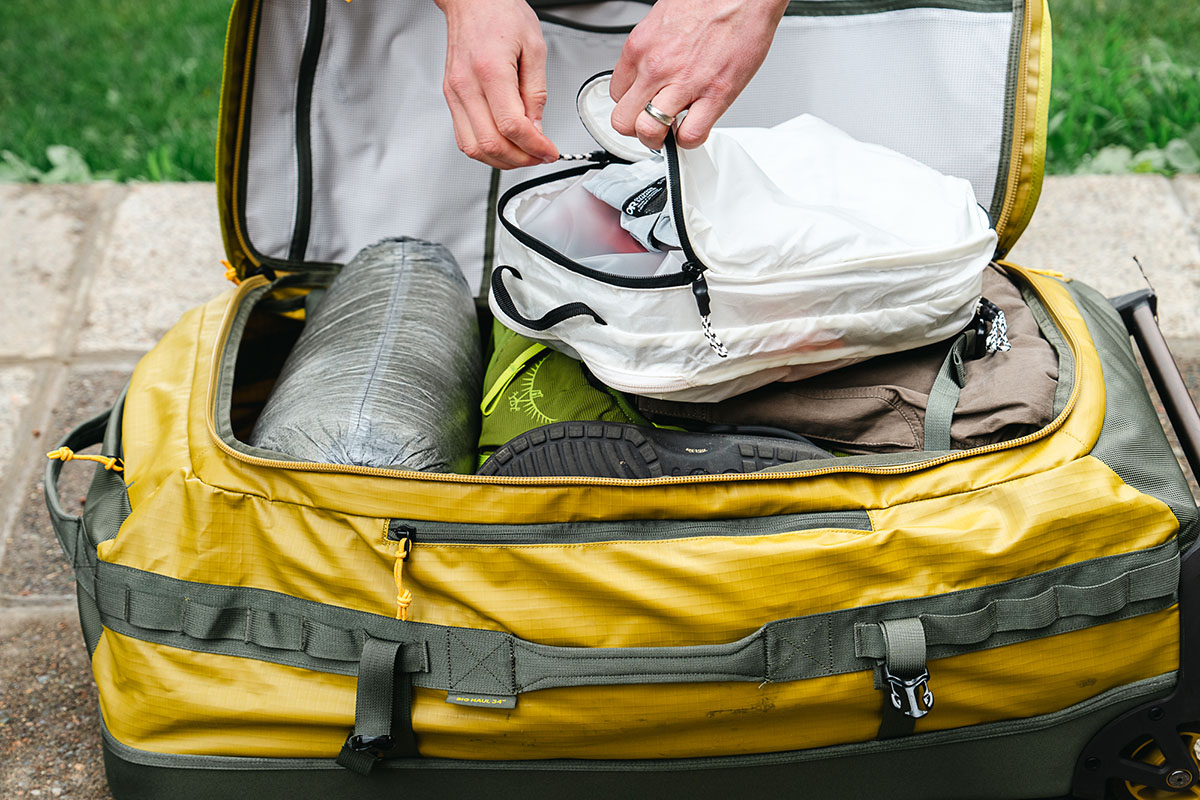
The packs above make it easy and comfortable to shuttle your belongings across the globe, but not everyone needs a specialized design for travel. Duffel bags are another popular way to fly with a lot of clothing and gear, and many modern designs come with deployable backpack straps for more easily hauling through airports and around urban areas. However, duffels lack the impressive assortment of dedicated storage compartments and pockets for items like keys, passports, and electronics, are generally less comfortable to carry over long distances, and often don’t meet carry-on size requirements.

Alternatively, some travelers may opt to use a standard backpacking pack. This can make a lot of sense when you’re traveling to hike, backpack, or embark on other adventures and plan to use your pack both for travel and for outdoor use when you arrive. Again, however, the lack of travel-specific features and organization options can make it harder to effectively divvy up your belongings. In the end, if you plan to fly domestically or abroad with any regularity (more than a couple times a year), we think most will find the investment in a dedicated travel pack worth it.
Back to Our Top Travel Backpack Picks Back to Our Travel Pack Comparison Table